It looks as if the same team of Japanese researchers who took the first still pictures of the giant squid have now succeeded in capturing one on video, though it is still unreleased.
Read more about it here.
It looks as if the same team of Japanese researchers who took the first still pictures of the giant squid have now succeeded in capturing one on video, though it is still unreleased.
Read more about it here.
Not too long ago, I read about the Barramundi in some fishing magazine. It's a fish native to Northern Australia that is not only puts up a good fight and is a good candidate for fish farming (unlike salmon, which is not only bland when farmed, but bad for the environment and wild salmon stocks) but it is also delicious.
In fact, it is number 36 on the BBC's 50 things to eat list. I got mine at the Portola Restaurant in Monterey Bay Aquarium. It was dusted with paprika, served on top of purple sweet potatos and fennel, topped with braised spinach, and garnished with a tamarind relish. The flesh was like that of sea bass, only richer.
Forget about talapia and catfish, barramundi is one sustainable option that I actually want to eat (and catch, if I ever get the chance).
How many songs can you think of that use the same chord progression as Canon in D (the Coolio song doesn't count because it straight out uses the piece, like Vanilla Ice took from David Bowie)?
We have video of a fish sitting on the molten sulphur and then moving off after a couple of minutes, apparently unharmed.link
I hope you like reading about fish, because I'm going to start posting more and more about topics dealing with the ocean and things that live in the ocean.
With the support and encouragement of my family, I've moved to Monterey after accepting a position with the aquarium. Though I'd ideally like to live in Southern California, I can't complain about living up here- the possibilities for hiking, diving, fishing, and other activities are more plentiful than I could have hoped for. They even have jiu-jitsu up here!
One thing is for certain: I am glad that I didn't have to take any of the jobs that I was offered in Orange County. With the exception of teaching sailing, I wasn't having much luck finding a job that I wanted to do. All of the jobs that I was offered where I could use Japanese left much to be desired.
Instead of making a pitiful amount of money, spending a few hours a day stuck in L.A. traffic, and working insane hours for a Japanese corporation, I'm going to be doing something that I want to do for a living and during my leisure time. I realize that most people are not lucky enough to get to pick and choose what they want to do, and am very grateful for the opportunity.
Life just seems so unreal sometimes. As soon as I've ended one leg of my "career", another one starts in a different place. I still don't feel like the adventure that I embarked on when I left for college has really ended.
It's cool to see what you end up with if you are always on the move. It turns out, in my case, that I don't need a lot to be content- clothing, a camera, some books, music, computer stuff, sports equipment, assorted tools, and my camera can all be fit into a few suitcases, and are all that I need.
Posting might be light for a while, since I'm still in transition. While I'm getting started up here, I think I'll buy a new computer. What a great excuse to get something that I have really wanted, as I've been without my own computer since I left Osaka! Hmmmn... What to get?
I just started watching Robot Chicken, and I like it.
Mark is referenced in the St. Louis Post in an article about the Hash House Harriers. My question: why did they omit the "ass" and keep the "Disco"? You can't have the Disco without the ass!
This sign reminds me of the opening to Happy Gilmore. I love the signs in Japan!
On Sunday, I went for a walk by the beach, where the Santa Ana River drains into the Pacific Ocean. I hesitate to call this place a delta, because this river, the victim of massive amounts of concrete and man's will to use every inch of real estate in So Cal, is severely channelized and is is really just a massive rain gutter. As I was walking by, this area really started to remind me of the Yodogawa.
The following pictures, on the top of the bodies of text, are those of the Talbert Marsh (Huntington Beach) area, and those on the bottom are of the Yodogawa (in Osaka).
Input/Output
North of the river, the Talbert marsh is flanked by a sewage treatment (I'm guessing this because of the smell) or some sort of wastewater treatment facility.
The Yodogawa doesn't stink, but I wouldn't eat any fish I caught out of it, nor would I go swimming in that water. That being said, the residents of Osaka depend on the Yodogawa as a water supply. This is one place in Japan where water does not taste good straight from the tap.
Life by the River
There is a whole community living in improvised housing next to the Yodogawa, and the trailer park on the Newport/Huntington Beach border have a similar appearance. A key difference would be that the people living in Newport are paying (and I bet rent isn't really that cheap, relative to other trailer parks), but the community living across from the Osaka side of the Yodogawa are very resourceful homeless people.
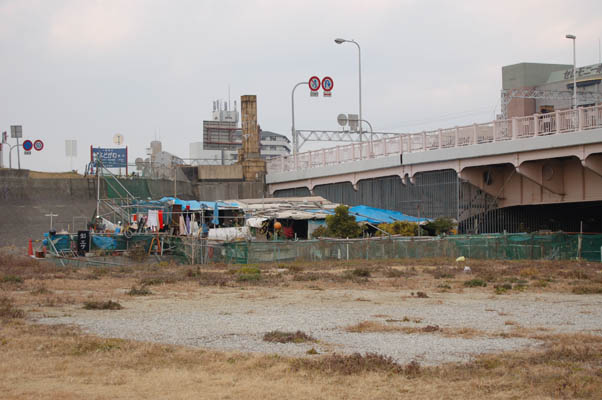
Waterfront Property
Another thing that these two groups of people share is that they both live in an area with a fantastic view. These wetlands provide a home for people and for a great assortment of birds.
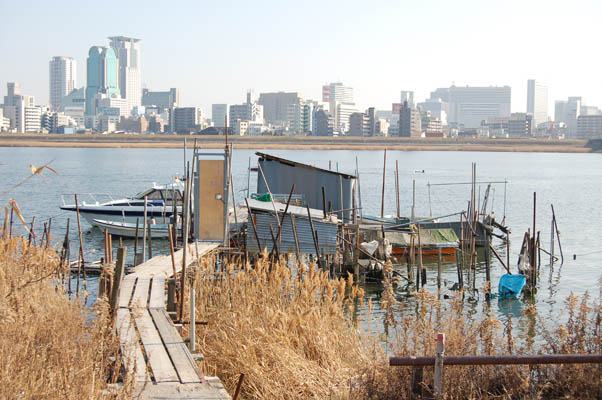
Invisible People
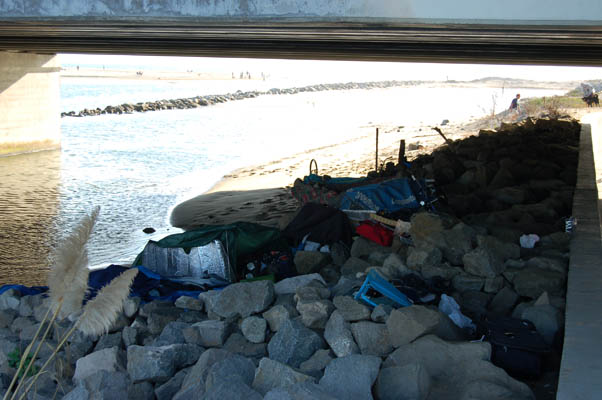
There are homeless in both places, but not so much in Newport Beach. In both cases, I found their makeshift houses under the bridge, and out of view of the public eye.
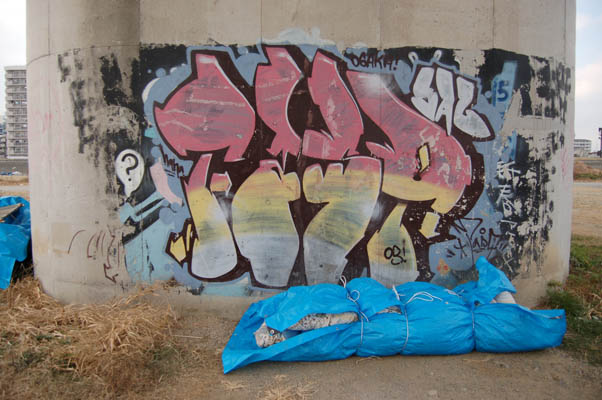
Juxtaposition
Concrete, asphalt, and rusted iron girders don't blend into their beautiful surroundings. These are the places that people explore and fewer have to depend on for shelter. It must get cold during the winter time, especially along the Yodogawa. Where do they go when it floods?
Boundaries
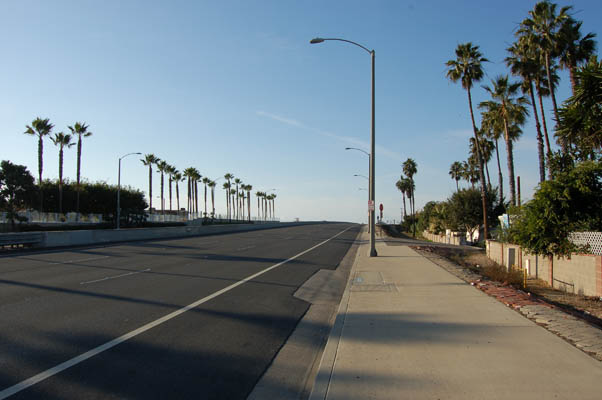
In this one block of Newport, the Pacific Coast Highway divides the wealthier from the trailer park. You can see that the people who live next to the beach have a glass wall that blocks the noise, while the trailer park has little to mitigate their situation (the top of low brick wall is at street level).
The Yodogawa is the border that separates the more upscale Umeda from the seedier Yodogawa-ku, across the river. I liked to spend time on both sides- Fireworks, house parties, and festivals were more fun on the Yodogawa-ku side, while Umeda offered more places to shop, eat, and go out with friends.
Cat and Spanky are waiting to be fed, be it toes or avocados.
Here's Spanky, pictured after eating half of an avocado. They also like guavas.
I used to play video games regularly up until a few years back. For some reason, playing video games just stopped being something I wanted to do on a regular occasion, but if I need to get my Half Life fix without going through the hassle of installing it on my computer, I think I'll drop by this site: link
I caught a cold that prevented me from eating a proper Thanksgiving for the 4th year in a row, and I plan on nuking it.
Today I kept warm, making sure to dress in layers and stay in blankets. I drank a few liters of tea with honey (an antibacterial substance used by ancient people to treat infections, and more recently gaining popularity in modern medicine), and soup with a metric buttload of garlic. I've been taking vitamin C with a bunch of other supplements, along with Cold-Eeze lozenges and Theraflu - Nighttime Severe Cold. Just to be safe, I'm going to bed early tonight. With any hope, I will have obliterated this bastard by tomorrow morning.
I don't care that Thanksgiving is past, I refuse to wait another full year to enjoy my own Thanksgiving. As soon as I'm well, I'm getting myself the turkey, yams, stuffing, cranberry sauce, gravy, pie, and other foods that I've been waiting so long to eat.
BTW, the Theraflu tastes rather unpleasant, so I will not be happy if I don't see results...
Update: It's still with me, but I am seeing immediate results with a secret weapon- pizza topped with crushed garlic.
I am topping each slice of pizza with at least one large clove of pressed garlic, and toasting it in the oven. It immediately cleared up my nasal passages, and has given me awesome breath! It has the added benefit of tasting really good (my brother and I discovered this almost unheard of topping on a trip back to Huntington Beach when we were searching for the best pizza a few years back).
Equipment:
QX4
Assorted maps
Fishing poles and tackle
2 tents and assorted bedding
DC power converter
Generic LG mobile phone
Nikon D-50
2 SD memory cards
250 GB Buffalo external harddrive
Compaq Laptop
40 assorted music cds
This summer, I flew out to Chicago to meet my little sister and her boyfriend for a road trip back to Southern California. I was really excited to have an opportunity to explore such a large swath of my own country- it's crazy to think that in 3 years I have explored most of Japan, but at age 27, I still haven't managed to see many places in the United States.
I had no idea that I would experience culture shock on this trip. Maybe it caught me off guard, being a domestic trip where I feel familiar with the culture, language, food, etc... In retrospect, it's not surprising that things were different enough to make me feel like I was traveling abroad once you take the demographic differences into consideration, especially when you realize just how large America really is.
CHICAGO
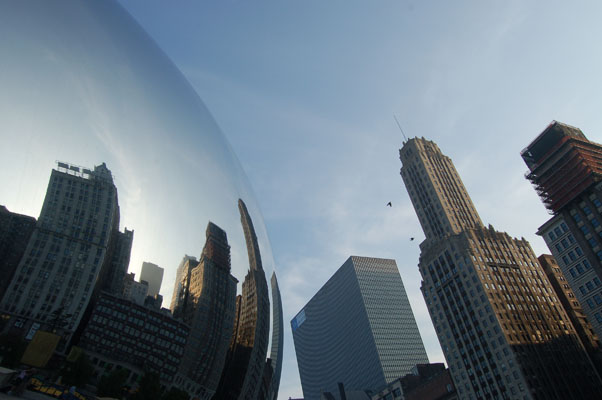
Ferris Buller's Day Off. The Blues Brothers. Common. Da Bulls. Pizza and sausages. These are the things that come to mind when I think about Chicago. It's funny, but these things, more or less, summarize my time in Chicago. Except I didn't get to see the Bulls. Or Common. Or Ferris Buller.
One of my favorite sketches from classic SNL is the Superfans, with Chris Farley, Mike Myers, and Joe Mantegna (with memorable apperances by John Goodman and Michael Jordan among others). The hot dogs and pizza are awesome, and it is a bit spooky to see how right on these sketches capture Chicago. "This", I thought, "is a place where I could easily become overweight, with the delicious food and weather that makes you stay inside and crank the AC or the heater to stay comfortable.".
I loved the deep dish pizza, sandwiches (from Potbelly Sandwich Works in particular), and hot dogs and sausages. It was strange being told that I was not supposed to put ketchup on the hot dogs though. I got no good answer for questioning why using ketchup was a faux pas- does anyone care to tell me why? People feel strongly, it seems, about tradition and their hot dogs in this city.
Riding the subway was a trip. We started from the Chinatown station, which had the strongest, most concentrated smell of urine I have ever experienced (which is saying a lot, because I used to live in Isla Vista when I attended UCSB).
On the ride into the city, it was interesting to see who got on and off. Getting closer to the city center, most of the black folks got off at once as the percentage of white people gradually started to increase. At one point, it was as if there was an invisible filter through which everyone except for white people had trouble passing through (this is not unique to Chicago by any means, its just more noticeable when you're riding on a train, which doesn't happen too often in So Cal).
I think we were the only Asians riding the train. It's strange to be in a place where you stick out like a sore thumb, yet speak a common language, share many aspects of our culture, and belong to the same nationality.
Chicago was a beautiful city with lots of trees, forests of deciduous trees, and scattered lakes. I was glad that I got to visit at a time when the weather wasn't too miserable, and wouldn't mind checking it out again at some point in time.
The things I enjoyed the most about the Windy City was the food and the botanical gardens. If I return, I intend to check out the music scene, to attend some sports games, and to try to find the best hot dog and pizza places.
After a week (or two) we finally hit the road in a QX4 that was stuffed to capacity with all of Merin's stuff and our traveling provisions. There was just enough room for 3 people to sit in.
MINNESOTA
The first stop was Minnesota's own Mall of America. I was underwhelmed by this really big shopping mall, probably because I don't like hanging out at malls and because their aquarium was closed. I can't believe that this place is the vacation destination for some people. Then again, I can never understand why South Coast Plaza is so jam packed with people during the middle of the day. Shouldn't these people be working or going to school?
SOUTH DAKOTA
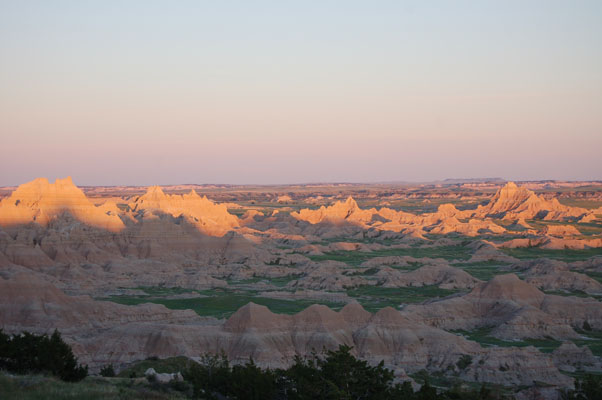
The next stop was the Badlands National Park in South Dakota. Here, you can see the very bones of the Earth being slowly ground away by the wind and water, painstakingly formed into landscapes from another world. Prairie dogs, bison, coyotes, and other animals (that I remember killing for sustenance in The Oregon Trail) fit in perfectly among the vast grass plains and the giant sandcastle-like formations.
Sitting at home or in the office, it is easy to romanticize life in the great outdoors. Insects, the fickle elements of nature, wild swings in temperature, and unexpected encounters with agitated dangerous wild animals will purge one of these silly ideas pretty quickly. Luckily, these things were not a problem. I didn't appreciate being woken up by a very noisy corvid, but I'll take that over being attacked mosquitoes or bears any day.
The Badlands isn't only a great place to see the prairie, awesome geologic formations, and wildlife- it's also rich in fossils. Walking along a creek, we found fossilized shells and what I think was the leg bone of a bison four feet under the soil exposed by the creek. I get the feeling that many of the early paleontological discoveries were made by people taking a walk in an unfamiliar place without the intent of finding anything in particular, just like we did. Not that we found a T-Rex or anything like that.
The Badlands was so cool that I think it deserves a separate post all by itself.
While in South Dakota, we also visited Mount Rushmore and 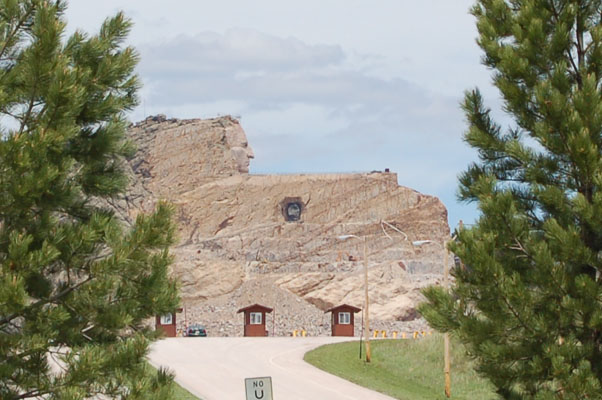 the Crazy Horse Monument. After growing up and seeing them on TV and in the movies, and studying them in the classroom, it was kind of an underwhelming experience. It also sucks that they charge you to see these things up close. In my humble opinion, it cheapens the experience, and deterred us from visiting the site It was fun taking pictures of my finger picking the nose of George Washington from the side of the road, though.
the Crazy Horse Monument. After growing up and seeing them on TV and in the movies, and studying them in the classroom, it was kind of an underwhelming experience. It also sucks that they charge you to see these things up close. In my humble opinion, it cheapens the experience, and deterred us from visiting the site It was fun taking pictures of my finger picking the nose of George Washington from the side of the road, though.
I didn't eat at Taco John's, a popular fast food restaurant in middle America, but I think I can safely say that is sucks. Call it "taco intuition", an ability developed over time by eating at too many disappointing restaurants that serve stuff that they call "Mexican food" and only once in a great while, finding some really good food. This place has liquid "nacho cheese" written all over it (Nacho cheese, while delicious, is neither Mexican nor is it food).
The only Mexican food that I ate on the trip was made of buffalo meat served on top of indian flatbread and topped with standard Tex-Mex condiments. This is one of the rare opportunities in which trying the regional ethnic food was even an option.
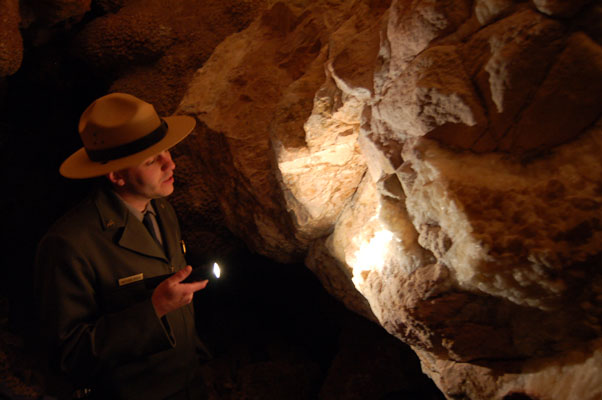
Jewel Cave was also a pretty cool stop in South Dakota. At 136 miles long, it currently the second longest cave in the world (it's still being explored, and it might one day claim the #1 spot). The rock formations are stunningly beautiful, and I would love to come back and go cave exploring. Notice I use the term "cave exploring". I'd rather go cave exploring than spelunking any day. Spelunking just sounds so...
Immediately after spelunking Jewel Cave, we checked out America's first national monument, Devil's Tower (also known as Bear's Lodge). This place was awesome. Indian princesses fleeing a great bear and climbing the rock into the heavens almost seems possible, looking at this massive column of basalt.
The reverence that American Indians have for this place reminds me of how aborigines feel about Uluru (or Ayer's rock, as the white man calls it), as do the problems that arise. There were some a-holes climbing this sacred site, even though there were signs posted by Native American groups asking people not to climb during what was a holy time for them. And people wonder why Americans have a bad reputation around the world for being disrespectful and rude. There is a very visible minority in our country that can't even treat each other with dignity, let alone people with different customs, beliefs, and languages. Sucks for the rest of us who enjoy living and traveling outside of our country.
WYOMING
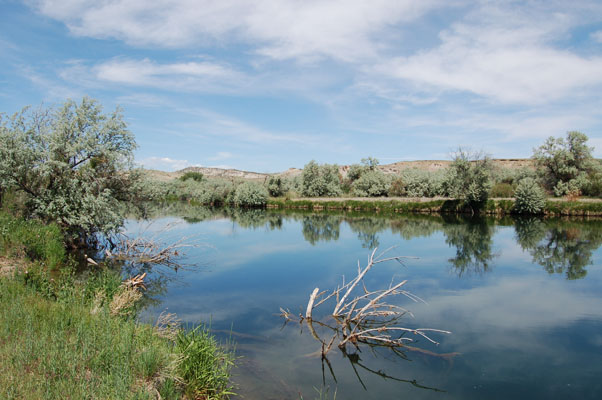
On the way to Yosemite, a waitress told us about a Thermopolis, home of the world's largest mineral hot springs. My arm was pretty scraped up- the results of an unsuccessful jump picture off of a small mesa in the Badlands. I will take any excuse to go to the onsen, and this one fit quite nicely.
Thermopolis turned out to be a land of extremes. The weather was so hot that I was the only one to go soak in the waters. I enjoyed this place, but it was decided to carry on to Yellowstone with haste.
YELLOWSTONE (located in Wyoming, Montana, and Idaho)
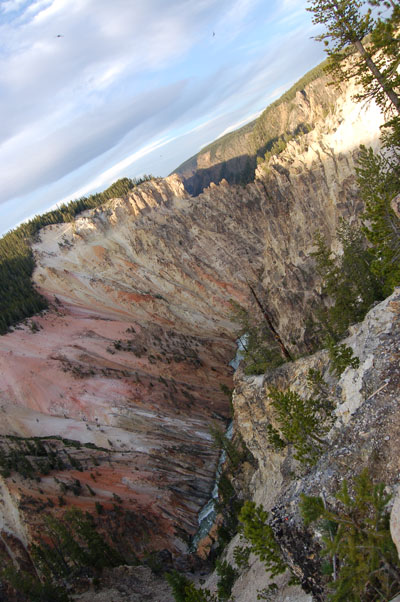
Yellowstone was more magnificent than I had ever imagined. This was nature as I had never seen in America, and I didn't even have to fly or hike for days to get here. Geysers of all sorts put Beppu to shame. It was as if my memories of the diaramas of the Natural Museum of History, that I had seen as a kid, had come alive.
For someone disenchanted with life in the city or the vast expanses of our suburban sprawl, visiting this place can be as profound an experience as I imagine making a religious pilgrimage to others is. This is a place that I would like to live in for an extended period of time.
If you do go, please, don't be a jerk and stop your car in the middle of the street, set up your tripod, and take pictures while oblivious to the line of cars behind you. It would be better for everyone else if you stayed in your apartment and watched the Discovery channel.
We fished a little bit along the way, with little success. While in the Grand Tetons, we saw a storm roll in over the mountains across from the lake. Just before the rain reached our shore, the trout went crazy, and were biting everything that we threw at them. When the rain reached us, the bite stopped for good. Ah, the mysteries of fishing...
IDAHO
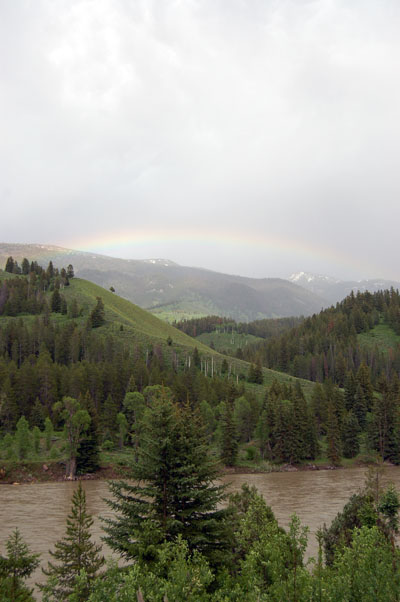
Potatoes are what come to mind when I hear the word "Idaho", but Idaho is much, much more than where we get our French fries and potato chips from. The land is beautiful beyond description, especially in those fleeting moments when the rain and sun fight for domination of the skies.
We drove through a land of lush green mountains, rivers, and fields, painted by light piercing the dark rain clouds. Above is only one of the many rainbows that we saw. This is one state that truly caught us off guard. I think that I'll have to find my way back up to Idaho one day.
From this point, we decided to just drive straight home and so there are no pictures of Utah, Nevada, or California. To sum up, I drove from dusk until dawn, sustained by a lot of caffeine and loud music. I do not recommend driving along the straight, long expanses of highway at night time, as it is tedious and becomes hypnotic unless you have someone to talk to. In the morning, when night sky started to hint of the next day coming, I found myself hallucinating, singing along to They Might Be Giants's album, Flood. We had reached California, and though exhausted, I spent the rest of the trip awake. It was a good finish to a good road trip.
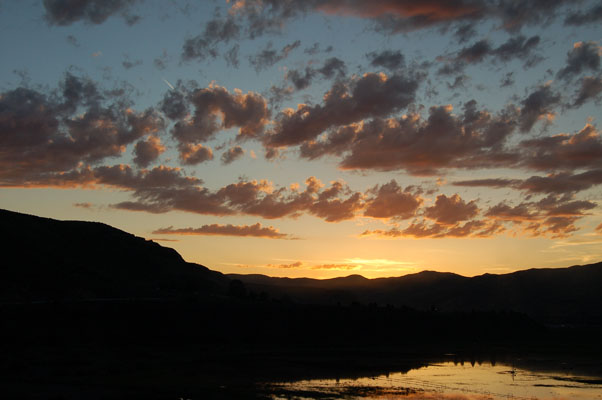
Road trips are awesome because you are constantly moving, trying new things, eating new food, and meeting new people. I feel as if my life kind of mirrors a road trip, as I have been able to do all of these things on a regular basis.
I think road trips should be a mandatory part of our educational system, especially trips to foreign countries overseas.
I don't think you can truly know what it is to be an American unless you spend some time out of your comfort zone, out of your culture, away from your family and friends. I don't think you can know what it is to be an American if you don't travel around the many different parts of America. How can you know what it is to be American, or any other nationality, unless you experience and explore other perspectives than the ones you are comfortable with? I don't think you can, and I know that I'm extremely fortunate to be able to have done these things.
Anyone up for a road trip?
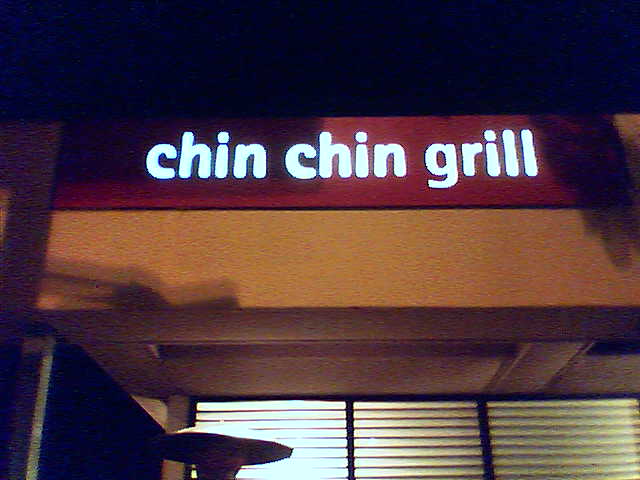
Mark and I saw this upscale Asian-fusion restaurant on Sunset Blvd. when we went to go see the Cut Chemist on Thursday night. With the amount of Japanese people who visit this area, they must know that their sign really means.
1) Italian (and sometimes French): 'Cheers!' Derives from the sound of the glasses clinking together.2) Japanese: Penis. Cause of much puzzlement when Italians travel to Japan, or when Japanese travel to Italy.
Italian guy: OK, here's to our time in Osaka. Chin chin!
Japanese guy: I beg your pardon?
It looks like HBO is working on a version of Band of Brothers in the Pacific theater.
link
The second season of Rome will be coming out next year.
HBO has renewed its epic drama series ROME for a second season, it was announced today by Carolyn Strauss, president, HBO Entertainment. Production of the 12-episode second season will begin next March, with the debut set for 2007.
It's too bad that I hate waking up early. You can see some pretty interesting stuff is you get up early in the morning. My bed usually wins the decision when I ask myself "should I get up or not?".
I must say that I don't sleep in nearly as late as I used to. At this point in my life waking up late is like waking up really early when I was in college. I wonder what will happen in another 10 years...
This is apparently what you get when you cross a whale and a dolphin. I'm a bit confused, though. If something can produce offspring that can produce offspring, isn't that the standard definition of a species (a category of biological classification ranking immediately below the genus or subgenus, comprising related organisms or populations potentially capable of interbreeding, and being designated by a binomial that consists of the name of a genus followed by a Latin or latinized uncapitalized noun or adjective agreeing grammatically with the genus name)? For example, donkeys and horses are not the same species because their offspring are sterile.
The same thing goes for ligers and tigons. It is hard to think of lions and tigers as being the same species, but doesn't their ability to produce offspring capable of reproduction make them just that?
I caught this set partway through, and noticed that the tracks sounded a little bit different. It turns out that J5 did a live in-studio session on NPR of all stations! This is worth a listen:
Beck is a genius!
Go check it out-
link
This is Bach and it rocks...
In order to make sure that the haniwa (here is another interesting article about haniwa) were completely dry, they sat exposed to the air and sunlight for 2 weeks. Since the smaller haniwa dry more quickly, I was able to fire the octopus, robot, and a few other smaller pieces prior to the bigger pieces.
This is the first group of haniwa. From right to left the group consists of a kabutomushi (rhinocerous beetle), a fugu (puffer fish), a bucket-headed sanshin player (made out of a gourd and bamboo stock), a ninja, a soldier with butterfly swords, a Taiko spirit, a Freeza-like spirit, and a Satsuma (not this Satsuma) samurai.
The second group is made up of a DJ, my version of a Daruma totem (a dual skull on top of a stormtrooper on top of a ninja turtle wind god), a snowtrooper (based on the kind that raided Hoth at the beginning of The Empire Strikes Back), a two-headed warrior wielding a naginata, a bear, the squid Pope, and a ronin bearing a cane sword.
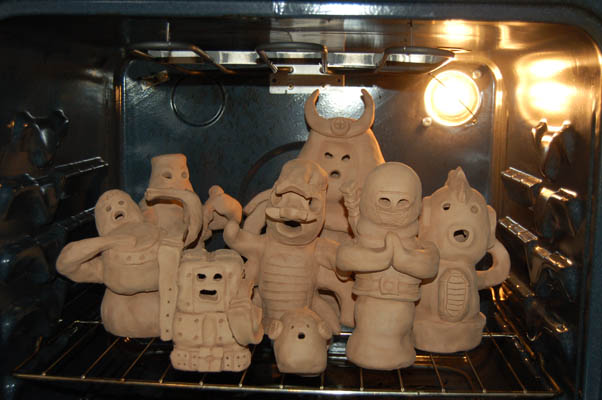
I fired the first group last week, and unfortunately, a few of them cracked. The samurai lost a piece of his helmet, the Taiko spirit lost part of his back, and the Fugu was badly damaged. I was able to fix them all with some super glue and used Gorilla Glue to fill in places where the fugu was badly damaged.
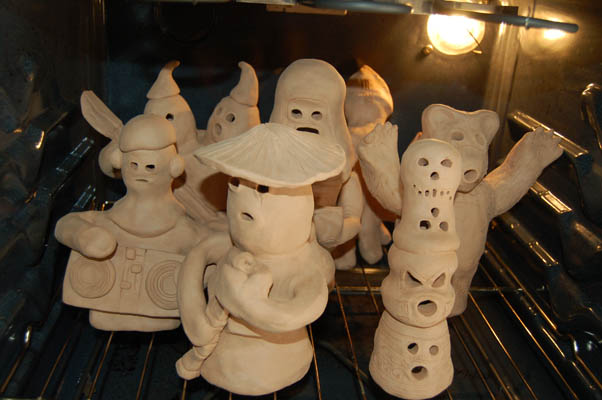
I just finished firing this group, and they all look like they survived the process intact. I guess it just took a little bit of time to refine my technique.
The clay I used was special in that it is made to be fired at 350 degrees for 1 hour, so I was able to do this in a household oven. I plan to make more as soon as I get more clay, but I need to find someone with a kiln so I can get those fired as well.
So far, the project is off to a good start.
In case you are interested in haniwa and kofun (Japanese burial mounds), these links might be of interest:
Sakai City's site
Charles Keally's Kofun Culture page
Kazumasa Ozawa's page about kofun
A page that shows what kofun look like from the air and ground
Abstracts from the Japanese Archaeological Association
A concise article about haniwa by the Cleveland Museum of Art
This picture has nothing to do with the news I just got from Chris, but it seemed appropriate somehow. I just learned that Sarah is pregnant, but I don't know when they will be expecting. I'll add more info to this post (or check the comments) as more news becomes available. Congratulations guys!
It feels weird to know that my brother is on a plane, and on his way, to a new life in Thailand. Over 10 years in Japan has molded him into an American who is very Japanese, so it will be interesting to see how he changes after being in Thailand for a while. Dude, best of luck!
On a side note, I think that your next car should be a turbo charged tuk-tuk.
It's hard for me to listen to the radio without constantly switching from station to station. It seems to me that there was a greater variety available on radio when I was younger, and now there's less space on the mainstream airwaves for anything other than pop, especially when it comes to hip-hop as this article points out.
Though there is new music coming out that I enjoy listening to, it is harder to find it. The pop has taken over like an invasive species- like the Kudzu vine has taken over the South, turning what used to be a space filled with diversity into a uniform plot of artificiality. MTV has only gotten worse about this over time, and when they do actually play videos, you can really see this. It seems like the formula of showing off material wealth and looking like a thug are enough to make you popular. But this stuff is just the same old noise, given new beats and repackaged.
Listening to radio today is like being forced to do your grocery shopping at a(n American) convenience store. No one can deny that the products it stocks appeals to the masses, and as much as I like things with nacho cheese and food that has an infinite shelf life, being limited to a diet of those things sucks. A diet of twinkies, skttles, and slim jims gets old fast.
Artists like the Roots, Binary Star, Talib Kweli, Common, Dead Prez, and Mos Def are seldom heard, and this is a shame. I'm sure I'm not the only one who wants to hear artists like these on the radio. When you have to listen to independent radio, college radio, and NPR to hear what anything other than the stuff that they rotate on the commercial stations, it is really frustruating.
I'd rather listen to nothing at all, rather than having to listen to songs like "Promiscuous Girl", or anything by 50, Ludacris, or Justin Timberlake(!?). I have nothing against this music, I just want to be able to choose to listen to something else without having to pop in a cassette or cd or boot up my computer.
I took Killer out to play with Boo and Yoda today, and after playing with a guava, he charged Yoda.
Yoda was a good sport. He played with Killer for a while, and just let the little puppy do whatever he wanted to.
Boo was less tolerant. He played with Killer for a little bit, but when the puppy started to get hyper, Boo gave him the one-two-neko punch! Killer whimpered for a bit, but went right back to playing with Yoda.
I find myself frustrated at how desensitized I've become towards the war in Iraq. The news is saturated with depressing stories day after day. Sometimes, I hear how many people have died in an explosion and think "That's not too bad.", and am sad at how these people have become numbers, as impersonal as the stock prices scrolling along the bottom of CNN.
I'm writing this post after reading this letter from Time.com. It's a good thing to personalize the war every once in a while, because it's way too easy to just tune out the noise all together.
Over the past week, I've been thinking about making our front garden into a haniwa forest. I want to make hundreds of haniwa and find the right places for them so that they become part of the environment of our front yard.
The haniwa of the Kofun period were guardians of tombs and tumili, but mine will watch over the home and garden environment in which they are to dwell. Who knows what forms they will take? Certainly not me, as I found out.
Today, I had an irresistible urge to sculpt haniwa. I opened up a package of clay, and slowly started to remember how to work in this medium. There is something very pleasant about working with clay- the earthy smell and cool, malleable properties of this stuff brings me a similar type of comfort that I get when I enjoy a hot cup of tea. They seem completely different, yet somehow they are linked in my mind.
I'm half planning what I want to make, and half letting the clay decide. This octopus came to be after I started to make it.
This robot haniwa was originally going to be a plain haniwa, but it clearly wanted to be a robot. That is the nature of haniwa. A spirit will take any form which it desires, as long as you let it. Hopefully they'll dry out without any cracks forming.
May peace be upon you.
Why do people like to dress up their dogs? I think that some people truly consider their dogs to be human and feel the need to clothe them. Others enjoy dressing up their dogs in the same way that children enjoy dressing up their dolls and action figures. I generally don't like to dress up pets, but this was just too perfect- my older sister had a bunch of butterfly wings hanging around so I had to tie them onto the puppies.
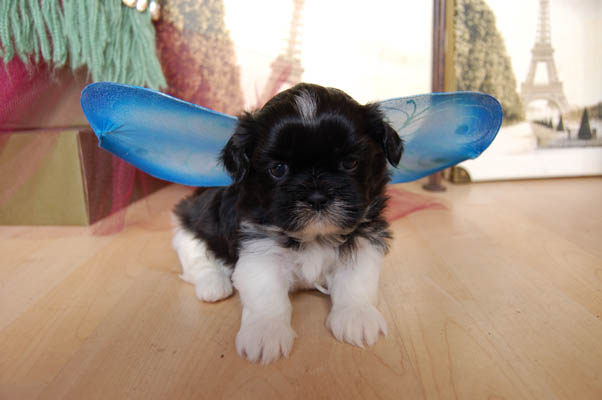
Have you ever seen such an unhappy butterfly puppy? If I dress him up any more, I think I'll give him issues, so I'm not going to make this a habit.
Killer's little sister doesn't like the wings much either, but she doesn't seem so depressed about the whole affair:
Though still a juvenile, the great white shark at Monterey Bay Aquarium exudes the presence of an apex predator. Nothing in the tank was running away from it, but they weren't coming near it either. Right now it's only 5 feet 8 inches, but I still would not want to fall into that tank...
This sign in front of Morro Rock (in California) makes me wonder, "Why do they want to keep us out?".
A big post about my road trip with my little sister looms in the not-so-distant future, but in the meantime here's a small taste of our journey:
We were walking through Yellowstone on one fine afternoon, admiring geysers like the one pictured above. Little did we imagine that one of our group would be taken down in a most unexpected incident in front of Vent Geyser.
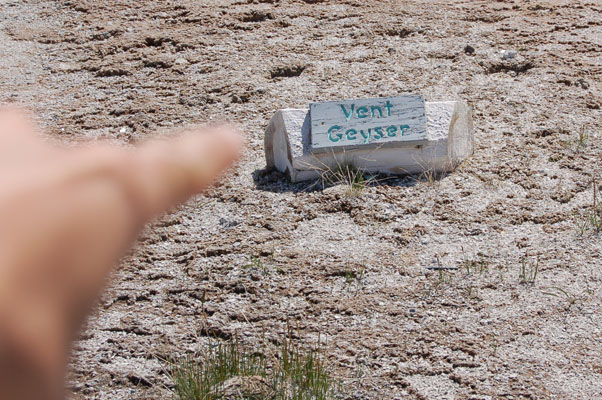
Extensive wooden walkways have been installed all around in order to minimize the impact that the park welcomes each year, as well as to keep people safe from the hazards of walking off of the known path. Once in a while, someone will wander off path and fall through the earth into super-heated water, resulting in burns or even death. It's refreshing not to be over-protected from things that can hurt you but won't unless you do something stupid. In a country where too many things are ruined for us all because some dumbass does something to ruin it for us all, it is nice to be able to go somewhere where you are given responsibility for your own safety.
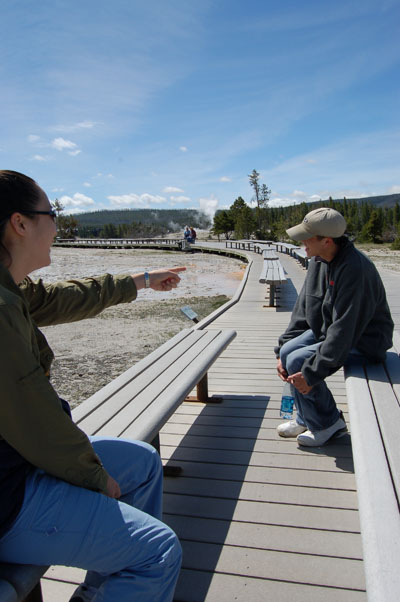
Merin is pointing and laughing at Chris, a fellow med school student at Rosalind Franklin University, after he got his ass kicked by a park bench. As he was walking along the edge of the trail, he failed to notice the bench in front of him and hit it with such force with one shin that he tripped and smacked his other shin into the bench seat before falling forward onto the bench. It looked and sounded painful, but no sympathy was forthcoming.
"It really hurts!", whined the pre-med.
"Hahahahahaha!", we replied. From that point on his responses, no matter what he said, elicited nothing but laughter. It still makes me laugh just thinking about it. He's not quite ready for the responsibilities that come with walking around shin high obstacles.
I live to take pictures so that I can remember moments like these. Yes, be proud America, for he is among the students destined to blaze the path of the future of medicine!
This entry marks the beginning of a series on a road trip that I took with my little sister and her boyfriend a few months ago:
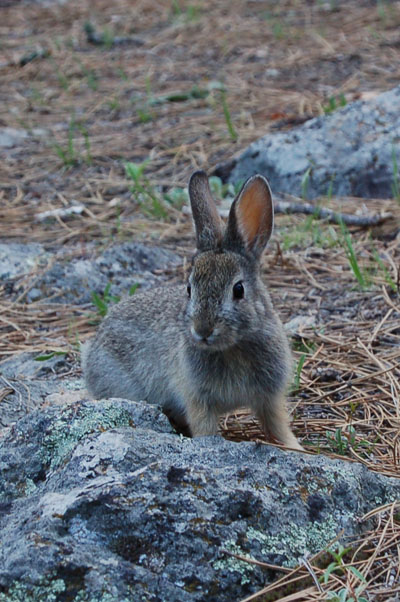
The rabbits have been out in great numbers everywhere. They don't seem to need much to proliferate. I've seen them in the grass, chaparral, and riparian habitats.
Young bunnies seem to be less spooky than the adults. This one liked to get really close, and then started spazzing out, running this way and that. I think I saw them do the same thing to coyotes on the Discovery Channel. I don't remember why they do this, butt it reminds me of the behaviour of young humans.
If you like bunny rabbits, you might check out Daniel Chong's short story.
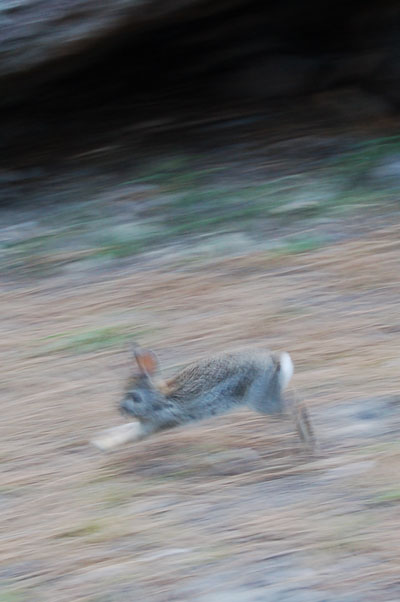
I tried stewed rabbit in France, and remember it being a mild, succulent meat. Trying rabbit was one of the first times that I tried something not usually eaten in America, and this experience set me on the path to eating animals, parts of animals, and other things that I would have never been able to try had I stuck to the McDonalds diet when visiting foreign lands. I'll take stewed rabbit over a Big Mac any day!
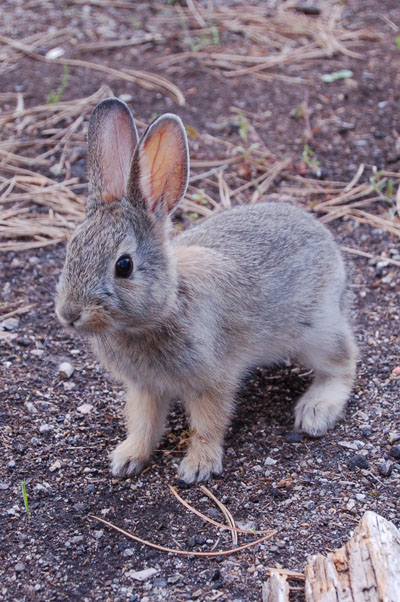
Doesn't he look cute/delicious? Mmmmm. Stewed rabbit.
Mopar sponsored an event that made for a strange gathering of people who either came to see their favorite NASCAR driver try and their hand at drifting, or to see some of the best drifters from Japan's D-1 circuit. I tried taking pictures of the event, but my lens was way too slow and I was too far away from the action. Though the pictures are way too blurry, the event was too interesting not to post them.
The Japanese drivers were, of course the highlight of the night. Unfortunately, we arrived a little late at the Irwindale track and missed most of their performance.
Seeing these guys race brought back memories of over 7 years ago, when I first saw cars like these tearing through the giant intertwined maze of bridges and streets in Yokohama. Back then, I had no idea what drifing was, and was amazed to see these cars evade the police with such grace and ease, and then returning shortly after the cops left to continue racing.
One NASCAR driver demonstrated how hard it is to drift in a NASCAR racer. I have to admit, it was pretty funny.
The NASCAR fans went wild watching their favorite drivers attempt to drift, but I quickly became bored of watching them.They didn't practice beforehand like they were supposed to, so we were watching them learn how to drift. Thankfully, the Japanese guys came back on the track for an unscheduled finale.
Bigfoot also had a go at drifting. Watching that huge truck lunge from side to side was entertaining, but this is not the Bigfoot that I remember from the old days. The old solid blue design was much better! Now the sponsor's name is written in larger print than the name of this iconic monster truck.
There were many strange things about this event: First of all it was sponsored by Mopar. It was also weird to see absolutely no Autobacs signs.
This was my first time actually being around NASCAR fans, and likely my last. I've never seen so many mullets in one place at one time! Nothing against NASCAR or the people who like this variety of racing, it's just not my scene. I'll take rally racing any day over doing donuts or drag racing.
I think the lesson from this event is to avoid Mopar sponsored drifting events, and stick to ones that are sponsored by Autobacs.
Killer is the first puppy of the litter to open his eyes.
Pretty soon he'll be able to walk about instead of just inch around like a caterpillar.
He's just eaten, so he wants to go back to sleep.
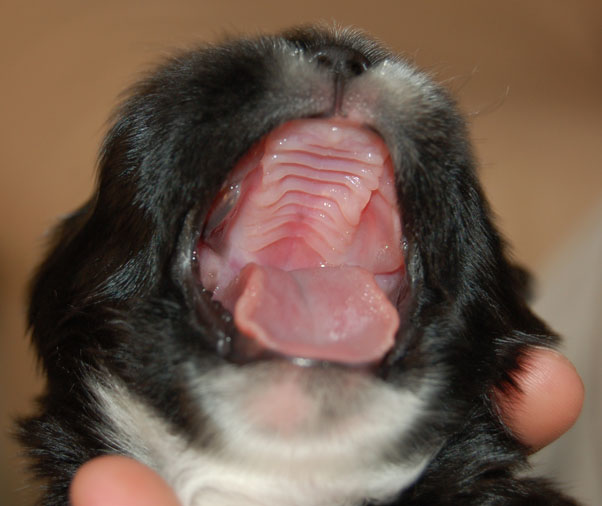
Over at Wired, Jennifer Granick makes an interesting comparison between the music industry and ramen:
People play guitar in all sorts of styles, riffing on notes the way the Japanese riff on the basic concept of Chinese noodles in soup. What if the original ramen chefs tried to stop others from developing their own ramen recipes and making differently flavored ramen broth?
They'd form an association -- say, the Ramen Industrial Alliance of Asia, or RIAA -- and announce a clampdown on the proliferation of infringing noodle shops. Their arguments would echo the music industry's. "The chefs who created ramen deserve to get paid for their creation," they'd say. "These noodle shops are taking profits away from the creators, while peddling an often-inferior product to an unsuspecting public that believes they are getting real ramen."
Just as the music industry claims that tab sites are publishing "derivative works" related to the original musical compositions, the ramen industry lawyers would argue that ramen varieties are derivations of the original product. Kyushu's tonkatsu (pork) ramen, Sapporo's miso ramen or Hakodate's shio (salt) ramen divert customers and take ramen sales away from the original chefs.
(link)
In a world of Maruchan, Nissin, and other instant crap, it's nice to know that somewhere, pig bones are slowly simmering over a low flame, releasing collagen and combining with the other ingredients to make a rich, delicious broth. Long live tonkotsu (and tonkatsu, but not in ramen)!
The cow patterned puppies will blend in well with a zebra pattern.
Their pattern against the zebra stripes reminds me of the dazzle camouflage used in WWII.
This one doesn't quite blend in as well as the other puppies.
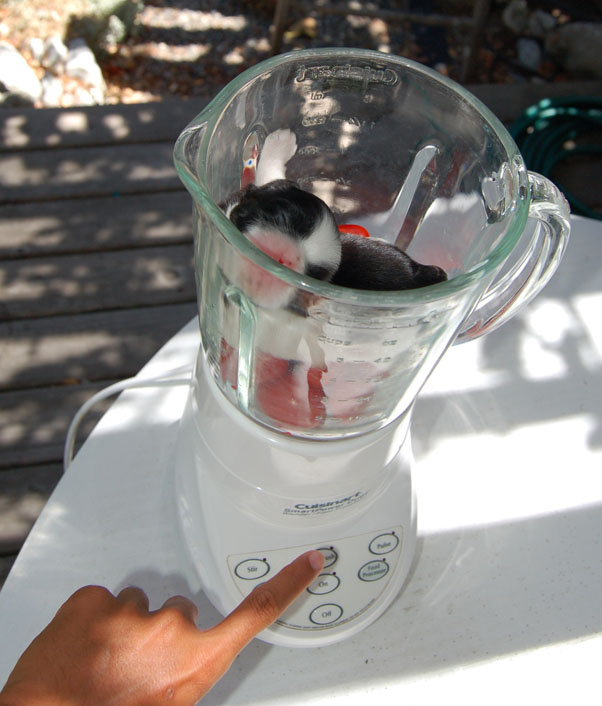
Young "Chunk" reenacts a dramatic scene from "The Goonies".
She fell asleep right on the keyboard. More shameless puppyblogging to come...
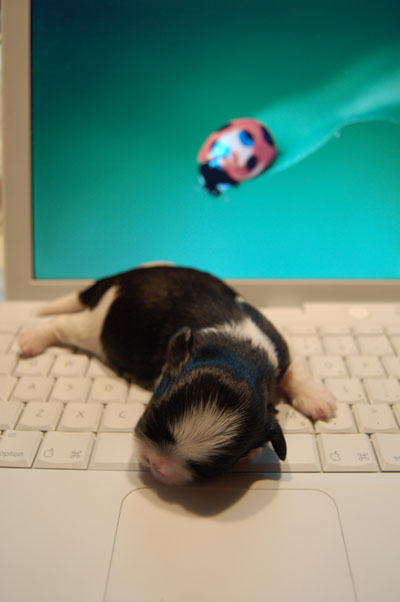
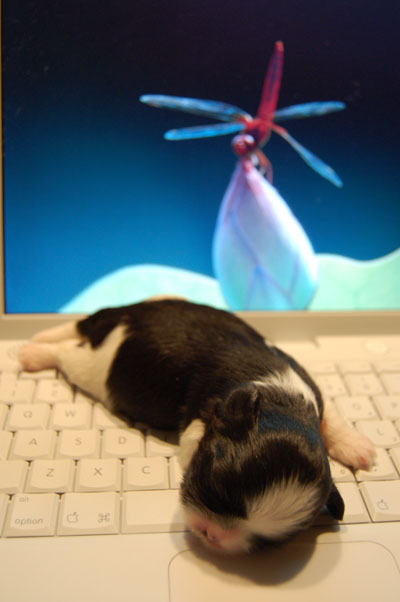
Up until a few days ago, much of Bolsa Chica was closed off to the public, so when I heard that they had opened it up I went to go check it out. The water under the bridge is murkier because the water is now able to get into and out of the estuary a bit easier, now that they have widened the opening to the ocean. You can already see a difference.
We saw about 6 stingrays in different places, all within a 30 minute span. This one seems to be missing his tail.
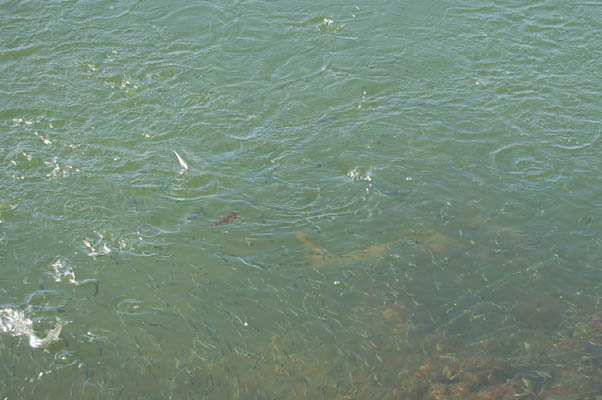
Something was scaring all of the smelt, and we couldn't quite make it out. Whatever it was, it was just shy of 2 feet long.
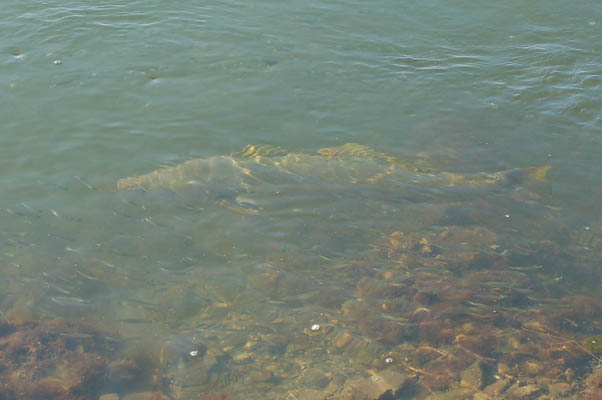
Upon careful inspection, it turns out to be a white sea bass! I have never seen these in Bolsa Chica before. And there were a bunch of them munching on the the smelt!
A few days ago, a school of bonita came up next to the docks in Newport and attacked the smelt as I was teaching a class. The frenzy only lasted 10 seconds, and when it was finished, there were a bunch of baitfish flopping around on the dock. This was exactly how it was in Catalina last weekend, except I have never seen this happen in front of the Sea Base or Sailing Center in the 10 years that I've been around this area.
I'm taking these unusual sightings as a good omen for the fisheries along the coast. It looks like things are starting to recover. It's about time.
All of these pictures were taken from the road as we traveled around Kyushu. Though the destinations were all great, getting there was half of the fun. These are some of the passing moments that we witnessed on our road trip, complete with commentary.
A old horse in Yufuin pulls an endless procession of tourists around town. This is some tired basashi.
The JSDF and other Jeep enthusiasts regularly drive their vehicles in the mountains of Kumamoto and Oita. In these areas, you can really put an ORV to the test.
The "Mika" sits in front of a massive ship on the coast of Oita.
Japanese construction workers dress like the Beastie Boys in their video for "Intergalactic". Or maybe it's the other way around.
Many of the bridges have fish on them. This one looks like a sardine.
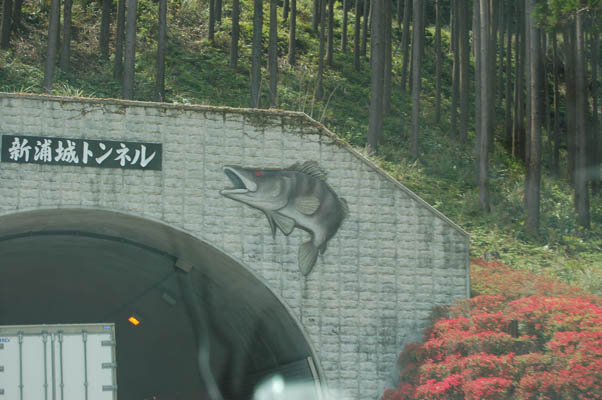
"Kick his ass, Sea Bass.". At least, I think this one is a sea bass.
If my little sister or younger cousins owned a storage container, they would probably do something like this to it.
Work is constantly being done on the two lane highways, and they use timed stoplights to direct traffic through parts where one lane is closed off. This is a good idea, except when you get stuck at one of these and have to wait a few minutes to proceed, even if there is no one else on the road. Sometimes people get impatient and go on a red. If you have the green, this can be a problem.
We barely made it across this narrow bridge. It was only just wide enough to accommodate our car.
Three motorcycle cops bust this guy on the stretch of expressway leading into the SeaGaia resort in Miyazaki. If you are traveling down this road, watch your speed. There are a bunch of speed traps, and an abundance of police officers riding bikes.
Driving through Miyazaki reminds me of home, with the beautiful beaches lined with tall palm trees.
Swans guard the coastline of a volcanic lake in the countryside of Miyazaki.
This would be a great bridge to take pictures of an old RX-7, hachiroku, or NSX. Having none of these handy, the Familia has to make do.
This antique pump is still in use. Sometimes, a word or simple phrase in Japanese is so much easier to convey one's sentiments than in English. In this case, that would be "monomochigaii".
Sometimes tunnels will focus the signal given off from radar guns positioned just outside of tunnels. Often times, speed traps are set just outside of the tunnels and around a bend, so it is wise to watch your speed when you come out.
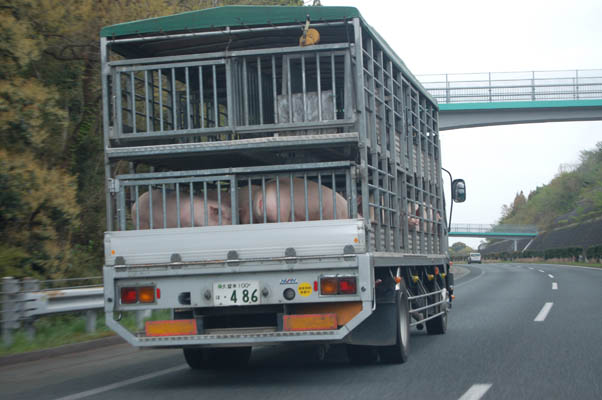
Tonkatsu? Shabu shabu? Yakiniku? These are the questions that go through my mind as we pass a truck carrying some pigs.
I love these animatronic dummies that pose as construction workers and cops. Often I have had the impulse to take one home for my living room, but have always exercised self-control.
Whenever I drive by a truck carrying petroleum products, I imagine what would happen if it got hit by a car, a carefully placed bullet, or a missile, and how much it would suck to be in close proximity to it if this happened.
Here's a picture of my former residence that I took while driving through Ubuyama. It still looks the same.
A fire k-car. There are smaller fire vehicles, but this one is pretty compact. These firefighters were taking a break on Daikanbo, eating soft serve and enjoying the sweeping view of the caldera.
I think it's kind of cool that this motorcycle group has boy's day decorations on their bikes. Friendly bikers are so much more pleasant than scary ones. Only in Aso...
This torii is built on the banks of the lake in the tourist town of Yufuin, Oita-ken.
This one and the next torii are in the small coastal city of Usuki, on the same grounds that house the magaibutsu.
The forests of bamboo and deciduous trees filters the light into intense beams that pierce the thick shadows. I can't describe it well, but these places evoke similar feelings that I felt when I visited the aincent churches in Toledo, Spain.
The shrine at Udo Jingu resides inside of a cave on the Miyazaki coastline. I recommend going just before it closes. There are fewer people at this time, which is always a nice thing. I got goosebumps walking through the cave and looking at the ancient shrine with the auto focus light on my camera.
This one is also on the grounds of Udo Jingu, on the way up a forgotten stairway to some ruins on the top of a hill.
A lava floe forced the residents of Sakura-jima, in Kagoshima-ken, to flee for their lives. Days before, the water started to bubble, and dead fish floated to the shores of the volcanic island. Those wise enough to heed the warning escaped. This torii stands next to an elementary school on the island, mostly buried in magma that has frozen into volcanic rock.
This torii stands in front of a shrine on the entrance to Iso Teien.
Tucked away in the gardens of Iso Teien, on the outskirts of Kagoshima city, is this Torii that serves as the entrance to the tombs of members of the Shimadzu clan.
A strangely pruned tree sits in front of a shrine in Kagoshima. I think it's supposed to be a bird.
The body of Miyamoto Musashi, the greatest swordsman of all times, rests just outside of Kumamoto city in a peaceful park in the town of Musashigaoka. It is a nice place to enjoy the momiji in the fall, and the sakura in the spring. Surprisingly, not too many people visit the park. It's kind of sad, but most people know Musashi, not from reading "The Book of 5 Rings" or the book by Yoshikawa Eiji, but from the NHK television series or from the "Vagabond" manga.
I look at the words of Henry Cisneros, a former mayor of San Antonio, and am sad that he didn't do his research or bother to write a better tribut to Musashi. Words that would almost guarantee anyone else an F on an elementary book report are cast into bronze for all to cringe at.
How do you take down a whole school of swordsmen bent on killing you to protect their honor? With a katana in one hand and a wakizashi in the other. This is when it helps to be ambidextrous.
Here is Musashi demonstrating several positions where he holds 2 swords. Before Musashi, Japanese swordsmen pretty much only used 1 sword at a time to fight with. Fast forward to present day swordsmanship and the arts of kendo and iaido. No one uses 2 swords! Oh well. Kendo is kind of disappointing to me anyways, as are the other martial arts that have been made into sports.
It is interesting to note that Miyamoto Musashi prefered to use a wooden swords in his bouts. According to some accounts he defeated Sasaki Kojiro, a prodigy of the nodachi (a long two handed sword), by carving a sword out of an oar that he found in the boat that he rode to the site of their duel.
We departed from Huntington Harbor at 1A.M., bound for Catalina Island. The plan was to look for kelp paddies along the way, to go after the mahi mahi that had come up from Mexico along with the warmer waters, but we had just missed the bite by a week. Though we didn't bag any dorado or yellowtail, the trip was still a lot of fun, and we limited out on bonita.
After catching some calico bass just before sunrise, we decide to go look for kelp paddies off of the coast of Catalina. We reel in, anchor up, and head out.
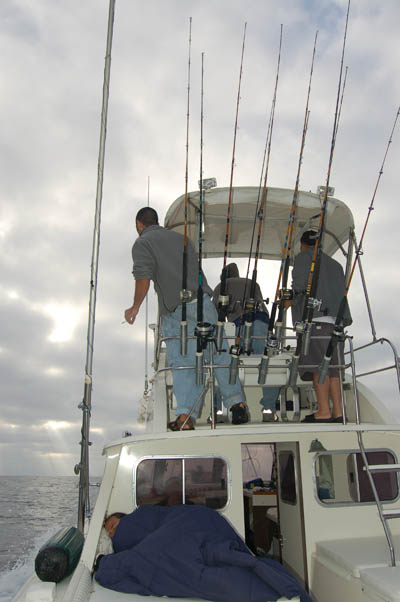
Kelp paddies are hard to find, so every extra pair of eyes helps. We're also scanning for boils on the surface, whales, and flocks of sea birds that might indicate where the fish might be.
We spot some small whales and dolphins breaching the surface, but they're loosely grouped together. It doesn't look like there are any fish with them so we part ways.
We toss in a net full of bait and get our lines in the water next to a paddy in hopes of raising some big fish. Nothing is biting, so we return to the island.
Matt hooks into what he thinks is a tail...
...but ends up being a baby calico. Our bait is bigger than this fish!
Our sardines are too big for the perch and blue bass to swallow, but they like the frozen squid. So do the calicos.
We bag a sheepshead...
...and then all hell breaks loose. Boils appear all around us in every direction. Several large schools of bonita and barracuda swarm up and down the coast, attacking the balls of bait fish. The small anchovies breach the surface in an attempt to flee the ravenous predators. The carnage is an awesome sight to behold, and I am too busy to take a picture. If you have a line in the water, is is almost impossible not to get a fish on your hook! This is the very definition of "wide-open".
Bonita flop all over the deck, as we pull in fish after fish. The deck becomes a sticky mess of oily, dark blood. The fish stop going after our big sardines, so we switch to iron. Krocodiles and blue and white UFOs are like magnets to the bonita.
A seal is drawn to the commotion, and tries to get our fish as we pull them in. It's a race to keep our fish away from this persistent pest. Luckily, we're able to reel them in fast enough to land them intact.
We quickly fill up a sixty gallon cooler with fish, and then top off a separate 40 gallon chest. The boat looks like the scene of a crime, with blood spattered everywhere. We rinse the deck down every few minutes, but new fish just spurt more and more blood everywhere. We limit out on bonita, and decide to start heading home just before 4 in the afternoon.
On the way back, Alex clears what ends up as well over 50 pounds of fillets, and the trail of carcasses attracts a flock of seagulls. One of them goes after a cedar plug that we're trolling. Luckily, we're able to get it off the hook relatively unharmed and it flies away.
We come into port just after sunset, clean the boat and our equipment, and head home after a great day of fishing at Catalina.
I'm not one to regularly write posts about my pets, but I'll make an exception because our shih tzus just had puppies. The ultrasound predicted 5 of the little guys, but we ended up with 5 females and 2 males.
Here's little "Killer" being born. He is clearly the most vocal of the group.
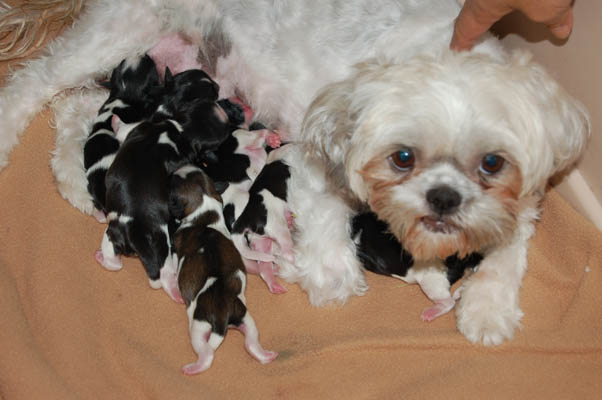
Molly is exhausted after giving birth to 7 little puppies.
Jack, the father, is freaked out by his little squeaking kids. He maintains a good distance away from Molly and his new family, and paces around nervously.
The pups literally fit in the palm of your hands, with room to spare. About the perfect size for a water balloon toss or juggling.
More puppy blogging to follow...
I don't know how this fish tank works exactly, but from what I could understand, the tank on top that joins the adjacent tanks works as a vacuum. The result is that there are feeding holes in the side of the tank, and the water does not flow out. I could not wrap my mind around this technology, but it works.
The fish were swimming between the side tanks over the tunnel. The smarter fish would swim across to the side where we were giving them shrimp.
As you can see, the water stays within the half bowls that are affixed to the side of the tank.
You would think that the water would come gushing out, but it doesn't. In the words of Arthur C. Clarke, "Any sufficiently advanced technology is indistinguishable from Magic.". Yup.
These are all fish that you can find off of the coast of Oita.
This guy got a little carried away and jumped out of the tank. He was delicious!
A brightly colored wrasse goes after some krill and misses. Not the most coordinated fish in the tank...
This rockfish was by far the most tenacious fish in the tank. He boxed out all of the other fish, until he had his fill.
The squirrel fish was a bit harder to lure out.
A trigger fish takes his time, and grazes on a shrimp buffet.
This is my favorite picture of the lot. Puffers, box fish, and cowfish all make me happy for some reason. They're such goofy fish, and tough to boot.
Mexican food is not very popular in Japan, so I was surprised to find a taco truck (a broken down k-jidosha) while walking around the quaint town of Yufuin, Oita.
My father orders a taco from the old lady, and finds out that she learned how to make tacos in Mexico. Tacos don't get much more ethnic than that...
There is no carne asada, carnitas, biria, lingua, or chile relleno here. The vendor takes out a block of homemade roast beef, and puts a few slices on the grill
We are offered the choice between a white or "brown" tortilla. We go for the brown. The tortilla, much to our delight, is obviously hand made out of whole wheat. A good tortilla is hard to get and can easily cost ten times as much as the going rate in the States(unless you shop at Costco). This is also put on the charcoal grill.
The taco consists of a tortilla, roast beef, onions, tomatoes, cabbage, cucumber, and hot sauce. Irrational as it sounds, I am relieved that there is no fish sausage in the taco. Could that be a surprisingly good combination? No. I don't think so.
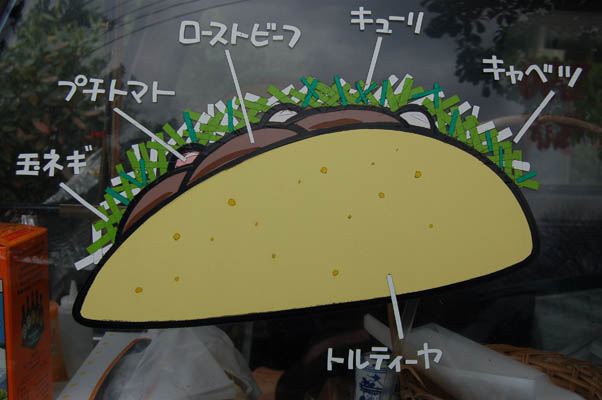
The taco is small, but it is a harbinger of food to come. It's as if I was destined to eat good Mexican food.
My father enjoys his taco, but reflects that a nice large horchata would be nice. Horchata would probably go over well in Japan. After all, it is made of rice.
The Oita Marine Center catches a bunch of oceanic sunfish every year, and puts them into their salt water pool. Visitors are encouraged to feed the mambou, but it is best done from a distance. You have to be careful when you feed them, because their razor sharp teeth can easily chomp off a finger or two.
No, not really, but it sounds cooler when you make things sound dangerous! You can safely touch these guys without fear of harm. They actually kind of gum their food to death, like the elderly without their dentures. They mostly eat jellyfish and other easy to catch food.
The year before I taught at Engei High School, the previous English teacher had only made it a few months into her contract. From what I heard, she tried to discipline the students and lost. It all culminated on one day when the students acted up to such an extent that they made her cry and run out of the classroom. She left school and was in New Zealand before she knew it.
I started school, and the teachers were watching me, wondering how long I would last. This wasn't paranoid delusion, they actually told me that they didn't think I had the fortitude to be able to put up with the situation for more than half of a year. These teachers were lifers, who had seen many before me come and go, as they were doomed to repeat the process over and over again. Their light at the end of the tunnel was retirement, and they weren't going to waste any energy on the latest English teacher.
I was able to make it through a year and completed my contract. I had to use every resource and every ounce of my will in order to create a feasable curriculum without the help of any of the teachers. The disrespect in the classroom coupled with an almost complete absence of motivation on the parts of the students and teachers alike made work a formidable challenge, to say the least. It was cool being able to help out the students who wanted to learn English or about foreign culture, but by the end of the year I was burnt out.
I just received this letter from a colleague still working at the high school:
Dear Adam,Thanks for the recomendation letter. I appreciate it. I hope you are
doing well. By the way, you might be interested to know that the ALT who
replaced you quit 3 weeks into the school year and we still don't have a
new one. Nice, huh? Can you come back?? ha ha ha! ^0^
Sorry, I wouldn't come back even if they gave me a raise. Life is too short!
Reform in education, especially for the English programs at all levels of education, is sorely needed. There are people that can get the job done, but there is little interest from the higher levels to retain us. If the Japanese educational system will only pay for gaijin clowns in the classroom, then that is what they will ultimately end up with.
Right before I moved back to Southern California, my father and I embarked upon an eight day road trip, touring our way through the Southern Japanese island of Kyushu at breakneck speed. Each day, we traveled through an average of exactly 2 prefectures.
It is impossible to enjoy more than a fraction of what Kyushu has to offer in such a short time, but with a lot of thought, flexible planning, and a desire to explore as much as possible, we visited six out of eight prefectures and covered a good chunk of the perimeter of the island. The only prefectures that we were unable to visit were Nagasaki and Okinawa. In order to visit everywhere I wanted to go and do everything I wanted to do, we would have needed at least a month! Keep in mind that much of the distance traveled was on windy, ill-maintained country roads. Add to this an average speed limit of 50 kph, which many country drivers prefer to drive under, and it takes a lot longer to get from point A to point B.
Here is a rough outline of our journey:
Equipment:
Mazda Familia
Assorted Omiyage (spices, chocolate, beef jerkey, and assorted snacks)
Super Cat Radar detector
Kyushu Super Mapple
Extra-large map of Kyushu
Docomo D251
Nikon D-50
2 SD memory cards
250 GB Buffalo External Harddrive
Canon Wordtank G50
40 assorted music cds and Blink (by Malcolm Gladwell) on tape
Hohner harmonica
Day 1- Osaka to Kumamoto
My father and I depart from Itami, arrive in Kumamoto, and pick up our rental car, a Mazda Familia. We wanted an RX-8, but it cost about $200 per day.
After driving into downtown Kumamoto, we had lunch at the tantanmen restaraunt on the 7th floor of Tsuruya.After this, we dropped by Kumamoto castle and enjoyed the blizzard of falling sakura petals.
We meet up with some friends, and visit the Kumamoto Traditional Arts and Crafts Center (definitely worth a visit), watching local artisans make cutlery and make gold and silver jewelry in the local style.
After this, we eat ramen at Ajisen, and I go out drinking with Luke, his new girlfriend, Jin, and Joe. My father goes separate ways with a cousin, and they sample basahi with the local varieties of shochu.
We stop by The (now closed) Sharp and drank at Jeff's World Bar, the new Sanctuary (it's too bright and clean now), Cowboy (did 2 hours of nomihodai), and various places along the Kamitori and Shimatori.
I finally stumble in at 4 am to the Green Hotel after going to 2 other Green Hotels and being told that I was at the wrong place! That's what 2 consecutive rounds at a nomihodai joint will do to one's cognitive abilities, I guess.
Day 2- Kumamoto to Saga
I wake up with a hangover and quickly depart for Saga to visit relatives and friends.
On the way, we decide to visit Miyamoto Musashi's Grave in Musashigaoka en route to the expressway.
My father gets directions to our relatives' church, which turn out to be bad, On top of this, a typhoon starts to roll in. We overshoot our destination, and find out that we can not go past the Saga Airport, as the directions tell us to, because to do so would mean driving into the ocean.
Getting directions to Higashimatsura, from an old man who speaks with a strong Saga dialect, tests my comprehensional abilities of Saga-ben. According to the old man, it would take another 2-3 hours of driving to get to the city of Higashimatsura. Something is obviously wrong.
We give up and call our relatives, and finally find out that HIgashimatsura is the name of the church (which moved to its present location from the city with which it shares its name) is in Saga city, only 45 minutes away. They quickly come and retrieve us from the airport.
Our cousin takes us out to eat the famous beef from Saga. It is among the best beef I have ever had in Japan, which is to say, the best beef I have ever had. A cold mug of Malt's beer and a stomach full of wagyu eases my hangover.
We spend time going over family history, and find out just how hard our relatives had to work to get educated and earn money to save up for bringing the family over to America. Everyone had to work in order to send one child to school. Public education was non existant in those days, and education was not taken for granted. How much things have changed...
My father spends the night with our relatives, and I take the train to Tosu and stay over at the Tanaka's house. I finally get to meet Sachika-chan, Ko-chan and Kaori's baby, and take too many pictures of her.
We eat a homemade dinner of tonkatsu, miso soup, and daikon salad. Later we drink beer and reminisce about teaching and life in Ubuyama-mura.
I transfer the pictures of 2 SD cards onto my harddrive before passing out.
Day 3- Saga to Oita
The typhoon rages during the morning and I wait it out with Kaori and Sachika-chan. We buy breakfast from the panya in front of the Tosu eki and eat in their Subaru Forester. My father is 2 hours late showing up to the rendevous point. We depart, planning on stopping in Usa and a few other places on the way to the Oita Marine Center. We stop at Yufuin on the way, and find what is probably the only taco truck in all of Japan.
The weather starts to clear up as we continue to Usuki to visit the aincent stone Buddhas (an awesome sight) and eat some cheap and delicious bento and onigiri from A-Coop on the steps of the castle ruins.
The road to Usa is obliterated and impassable, so we regrettably don't get to see the largest collection of haniwa and head onto the Marine Center. Along the way, we drive through some great mountain roads along the coastline. They test my father's driving abilities, and there are a few hair-raising moments and appropriate expletives exchanged as a result. We climb an observation tower in the middle of nowhere and admire the view. The coastline is unspoilt by seawalls of tetrapods, a rare sight in this country.
As night sets, we check into our room at the Marine Center, and head to Usagi Tei, the local izakaya. The food is exceptionally good. My father especially enjoys the peanut tofu (he hates the boiled peanuts of which this tofu is made, but the alchemists in the kitchen have turned it into a culinary delight), and I enjoy the locally-caught yellowtail sashimi which is among the best I have ever eaten. This is, I reflect, the last sashimi of this quality that I will be eating for quite a while.
After another full day, we enjoy sleeping in a private room, in an almost deserted minshoku. We timed this one just right.
Day 4- Oita to Miyazaki
We eat a breakfast of salted fish, rice, nori, and an egg and bacon that we cook atop a sterno-heated ceramic pan, and spend the whole morning checking out the Marine Center/minshoku. We play with friendly sea turtles and oceanic sunfish, hand feed tropical fish in a seemingly impossible fish tank, and stroll around the sleepy fishing village.
We hit the road, and head south for Miyazaki city. Lunch is ramen at Gofu. I take many pictures along the way. Unfortunately, the weather turns bad, and we don't get to enjoy the famous beaches of Miyazaki.
The price of admission into SeaGaia, the famous indoor beach next to the beach, is prohibatively expensive, and we arrive when it is just closing.
Instead we visit Udo Jingu, a shrine inside of a cave on the Miyazaki Coastline, and throw little tablets into a hole atop a turtle-shaped rock for good luck.
There is no sunset today, but the transition from day to night is beautiful, regardless.
We have dinner at a local izakaya with Tsuji, a friend who I hadn't seen since high school. The jidori sashimi (raw chicken) is exceptional, and the liver turns out to be the highlight of the meal. We end the meal at a melon-panya outside of the izakaya and part ways.
My SD cards are full again, so I stop at a Cybac, pull the gaijin card, and avoid paying membership fees. It takes 20 minutes to transfer all of the files to my harddrive. It's nice to have enough space to store all of the pictures that I have taken.
We stay at cottage Himuka, and regret that we are not able to use all 4 beds. This place would be good for a larger group vacation to Miyazaki. Maybe nextime...
Day 5- Miyazaki to Kagoshima
Breakfast at Himuka is unspectacular, a Japanese-continental spread. The bacon is limp, the sausage lacking in flavor and texture, and the eggs are over-cooked. Cereal, salad, and fresh fruit take up the slack, but we are itching to get on the road. A gaijin dad and Japanese mom scold their children in the next table over. Poor kids. The father looks like a proto-expat who has clearly overstayed his time in this country.
We hit the expressway from Miyazaki to Miyakonojo. Here we stop by a waterfall, and take a hike in the rain.
It is refreshing, and a welcome break in between.
On the way to the ferry, we get lost in the woods and ask some locals working at a small lumber mill for directions. They speak in a deep Kagoshima-ben (one of the hardest to understand dialects in Japan) and draw a map on a crosscut section of cedar. The directions, unlike their dialect, are very easy to understand and get us back on track.
We arrive at Sakura-jima, the famous volcano that sits across the bay from the city of Kagoshima, and explore the desolate landscape.
Due to continuing vocanic activity, we are unable to proceed up the volcano.The roads have been torn in two from fissures in the earth and eroded/covered by lahar after lahar.
We take the ferry from Sakurajima to Kagoshima city,
and I have a decent bowl of udon and enjoy the view. We see bullet holes in the castle walls as we drive through the city to, Iso Teien, our next stop.These spectacular gardens were built by the powerful Shimadzu clan of Kagoshima. We spend the better part of the day enjoying the museums and hiking around the massive grounds, until it almost closes.
Towards the end of the day, the sun finally peeks out through the rain clouds, and gives us a clear view of Sakurajima.
We visit the cave where Takamori Saigo hid after his defeat, and reflect on how bad of a movie "The Last Samurai" was for making Tom Cruise the protagonist. Saigo was clearly the man.
We drive up to the nearby mountains and enjoy the view of the city while eating some top-rate eclairs from the Castle Hotel.
The hotel maintains beautiful gardens, and has a small museum inside. Their workers are mostly young and attractive women. If you have a lot of money to burn, this is definitely the place to stay.
Next, we stop by the site where Saigo commited seppuku and pay our respects. After his suicide, a trusted liutenant took Saigo's head and buried it in a secret location, to uphold Saigo's honor and deny the enemy the trophy which they so greatly desired. To this day, no one knows where Saigo's head is hidden. I bet it's inside the caldera of Sakurajima.
We eat dinner at a local izakaya. The seafood, though limited, is pretty good, but no one dish stands out as exceptional. Since we have a drive ahead of us, we refrain from drinking. It feels weird not to drink in an izakaya, especially when you're on vacation.
It takes about an hour to get to Satsuma no Sato, our secluded ryokan in the mountains of Kagoshima.
To our surprise, our names are written in the Roman alphabet on the genkan board and one of the hostesses speaks really good English. It turns out that she was born and raised in Seattle, and moved back to Kagoshima a long time ago.
This ryokan had the honor of hosting one of the Emperors. It is exactly what I picture an old school ryokan to be, complete with a Japanese garden, a full set of samurai armor, and Japanese art skillfully displayed to complement the summer season. We enjoy a piping hot radon onsen, and then have a well deserved beer before hitting the sack.
Day 6- Kagoshima to Kumamoto
There's nothing like starting your day off in an onsen, and this proved to be no exception. After meditating, my father is ready to get on with the day.
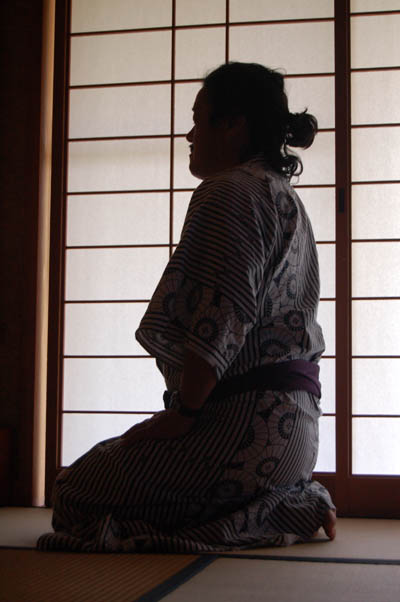
We depart from Satsuma no Sato refreshed after a good night's sleep.
On the way, we stumble upon a lake inside of an extinct volcano. The town next to the lake obviously has a thing for dragons. The largest waterwheel in the world had a dragon on it, as does one of the bridges, among other things designed to lure in tourists.
Next, we jumped on the expressway to Kumamoto to the 57 and rode the Milk Road back to Ubuyama-mura. I finally get to take a picture of a sign that I never got around to taking while I was living there.
I visit all of the old schools that I used to teach at, and am happy to see all of the children again. They are so much bigger than I remember, and I enjoyed talking with former co-workers and students. Life has remained unchanged up here in my little mountain village.
We eat a lunch of yakiniku at Yama no Sato, where they have several types of tsukemono.
Unfortunately, the akaushi was not as good as it used to be. Cooking the beef atop a piece of volcanic rock is pretty cool, though.
We visit the springs at Ikeyama and Yamabuki, and then head leave Ubuyama for Yamaga via the Milk.
I was fortunate enough to be able to meet up with a lot of old friends. First, we stopped by the Otsuka's (Joe's host family) house and talked about the Kumamoto beef industry. Unfortunately, it's not doing as well as it was doing, but hopefully it will recover. The Otsuka family runs a cattle ranch, and produce beef that rivals that of Kobe, Saga, or just about any beef in Japan. Time is short, so we bid farewell, and head over to Aiko's house.
Jamie, Dave (sh*tf*ck), Emi, Chie, and Aiko are all waiting for us.
We enjoy some freshly harvested takenoko and drink a lot of beer and shochu, while reminiscing about the good times on JET. Those guys are still doing the program, and having a good time down there. Aiko's family is kind enough to let us spend the night, and we quickly fall asleep.
Day 7- Kikuchi to Kumamoto City to Aso
We eat a simple country-style breakfast of takenoko, tsukemono, and chasuke, and bid farewell to Aiko and her family.On our way to Kikuchi, we stop by Matt's old village and take another onsen in Kikuka town. It costs only 300 yen, a bargain! Continuing on to Kikuchi gorge, we hike in the rain yet again. Kikuchi gorge is just as beautiful as I remember, though it isn't quite the right weather to go for a swim.
After the hike, we meet Hieda-sensei, a friend of mine as well as the former art teacher in Ubuyama. He takes us to Kokutei, a famous ramenya in Kumamoto city and his favorite place to go for a bowl of noodles. The tonkotsu broth is fantastic even by Kumamoto standards
It is good to hear that he no longer has to travel 2 hours to visit his girlfriend. They now live right next to each other in the city, and have a lot more opportunities to see eachother. When he lived in Ubuyama, he could only visit 2 or 3 times a month! It seems like everyone who has worked in Ubuyama enjoyed working with the children, but they don't really miss some of the other things that come with working in such an isolated area.
We stay the night at the Starry Pension, owned by the Nakayama family. The starry skies of Aso and gentle chirp of the local crickets make for a very peaceful setting. We meet up with Kaori, Kikuko, and Sachika-chan, and enjoy a nice meal of steak followed by a private onsen with a view of the night sky.
Day 8- Kumamoto to Osaka
Nakayama obaasan once again prepares a delicious meal, and to our great surprise, she will not accept any money for staying over at their pension! Sadly, we have little time to spare, and bid a tear filled farewell.
We had planned to visit Kurokawa for a day of onsenning, but didn't have enough time. Instead we visit Daikanbo, and enjoy a soft-serve while looking down into the Aso caldera. The wind is strong, and cold, so we depart.
We have a traditional country style lunch of dagojiro (a miso-based soup with dumplings, pork, and vegetables), and takana meshi (takana fried rice) in a popular restaraunt filled with ornaments from all over Japan.
It is nice to have a lunch that is way too big to finish, and reminds me how country life is different from life in the city.
Even within the same country and prefecture, people have such different lifestyles from one another, and food has often been one thing that I can use to make comparisons. Farmers need a lot of energy to work in the field. I guess the same does not necessarily apply to the Calorie Mate and McDonalds fueled OLs and salarymen of the city.
Kikuko and Kaori bid us farewell, and we proceed to sample the many onsens at Aso Farmland. My favorites included the fujinohana onsen, and the inside onsen that glowed nuclear green under the blacklight. Yet another thing that I will miss about Kyushu when I get back to the States.
We drive back to the airport, return the car, and fly back to Osaka. This has been one helluva road trip!
Note: this entry is a work in progress...
Inside a book called "A Pocked Guide to China", there is an interesting comic that shows one how to differentiate between Japanese and other Orientals. As Angry Asian Man would say, "that's racist!".
I love wildlife photography, but I refuse to become a birder who totes around gigantic lenses and a tripod everywhere I go. I refuse to wear a Tamron backpack, or be part of a group of people shooting the same thing at the same time from a slightly different angle as the people next to me. So for bird photography, luck, creativity, and a bit of cropping will have to suffice.
This couple keep my Aunt, Uncle, and cousin up at night with their nocturnal shrieking sessions. I like nature, but I like my sleep even more. How many birds have gone extinct from keeping people awake at night? There have to be at least a few species who have been selected out of the gene pool in this way...
My sister said that I should climb the tree and try and retrieve an owl egg because it would make a good picture. I agreed, but suggested that my cousin should do it to let me take pictures of the action. There was a time when I could have gotten her to do it in exchange for the right amount of candy. Sadly, those days are past.
If the Dead Kennedys, Kraftwerk, and Devo all mated and had a Japanese love child band, it would probably look something like Denki Groove. The animation reminds me of early MTV commercials and Liquid Television remixed with Heisei Tanuki Gassen Ponpoko.
(via Pink Tentacle)
Bolsa Chica is a great place to watch the sun set into the West. The bright, golden glow of the fading light is something I never tire of, especially if I'm barbecuing with friends and family.
Walking along a channel, I followed a mysterious wake that seemed to defy the current. The murky water prevented a positive identification, but I would guess that the school of large fish that threw this wake were either carp or tilapia. They were too big to be the mullet native to this area.
There palm trees remind me of driving through Miyazaki with my father. I would have loved to have spent some time on those beautiful beaches. But today, I am looking forward to swimming in the Pacific Ocean off of Huntington Beach. It's been hot and humid lately, not unlike the summers I remember spending in Japan.
As I was feeding the cats, I noticed an animal looking down from our guava tree. This guy looks like he's taken some abuse in the face. Maybe he was trying to eat Yoda's food, and got clawed instead.
The opossum looks a lot like the killer rodents of unusual size that attacked the Man in Black in The Princess Bride, and makes a loud hissing noise if molested. I've never heard of them attacking, and used to catch them by the tail when I was a kid.
Another interesting thing about possums is that when they "play dead", they actually pass out from being overwhelmed by terror. I've never seen them do this though. The ones around here must be pretty used to encounters with humans and their pets.
This video reminds me of an episode of Jackass when Spike Jonze gets dressed up as an old man and goes all around messing with people.
Brian and Rebecca just got back from their honeymoon safari in Africa , and you can see the pictures they took here. With over 4000 pictures to edit, there will be more to come when they finally wake up and fight the jetlag.
Here is a picture taken on a recent driveway safari in Orange County:
Just got back from a two hour session of body surfing with Merin. The waves were decent today, and by the time we got out, at 6pm, the air and water temperature were perfect. Ball lightning blazed in the halo of clouds around our clear patch as the sun cast a magical glow as it set into the Pacific. I think I'll start going in the water more from now on.
There are so many sea otters off of the coast of Avila Beach that I can't remember exactly how many I saw. Anyone who doubts that otters are a keystone species need only go fishing up here to see first hand the relationship between otters and a healthy kelp forest, full of fish and other marine organisms. In order to get an understanding of just how rich a kelp forest is I went diving.
As you can see, a proliferation of kelp acts as a magnet for predators, a source of food, a nursery for juviniles, protective cover, and a home for many different creatures. By the way, this picture is actually from the main tank in Monterey Bay Aquarium, in case the way I posted this was misleading, heh. I have yet to dive this section of coastline.
My older sister, who volunteers at the aquarium, tells me the population of otters on the Pacific Coast is not doing too well right now, in general. A feline disease gets into sea water when people flush their kitty litter down the toilet instead of throwing it away, and otters contract this and die.
Another problem with otters is that they like to live where they grew up, so it is hard to reintroduce them into areas where they should do well. Otters that are dropped onto the Channel Islands have often swam all the way back across the channel, driven by their homing instinct to return to their points of origin to the frustruation of the marine biologist who worked so hard to put them there.
Here's a crop of a juvinile and an adult, chillin' by the kelp.
Snowy white islands look pretty, but tell a different tale when you're downwind. We were upwind, and even then the stench of guano was overpowering.
I miss really good Japanese food, the kind you can't get in the states. I miss the doteyaki and kushi katsu found in the seedier parts of Osaka, the fresh tsukuri, sushi, agemono, okonomi and monjayaki, dagojiru and butajiru, assorted nabe, goya champuru, yakiniku, kushiyaki, takoyaki, katsudon and katsukare, basashi, soba, udon, and the wild combinations found at tabehodai/nomihodai joints. But most of all, I miss the tonkotsu. Good ramen is hard to find over here, and good tonkotsu is all of unheard of.
Some of the recipes found at The Official Ramen Homepage are actually starting to make me a bit hungry. Here's my contributions to instant ramen recipes of the same vein:
Korean-American Style Instant Ramen
Ingredients
1 package of ramen
1/2 cup of the kimchee of your choice
2 hot dogs, chopped
1 egg, scrambled
korean beansprouts
korean seaweed
green onions
Directions
Cook the noodles for a few minutes while boiling some hot water for the broth in another vessel. Discard the nasty oily water. Add the hot dogs, kimchee, and egg to the new water, and then the noodles. Serve in a bowl and top with korean beansprouts, seaweed, and green onions. Serve with a tall glass of Jinro (for real men) or an ice cold bottle of Hite.
Instant Chow RaMen
Ingredients
1 package of ramen
chopped onion
chopped garlic
chopped red or yellow bell pepper
chopped mushrooms
sesame oil
oyster sauce
shoyu
salt and pepper.
chopped beef or chicken
oyster sauce
chicken broth (or use the soup base from the packet to keep it ghetto)
corn starch
Directions
Marinate the meat in shoyu and oyster sauce for a half an hour. Cook the noodles for a few minutes, discard the nasty oily water, and set aside. Stir fry all of the ingredients, then add a bit of chicken stock and corn starch to thicken. Add salt and pepper to taste. Fry the noodles in sesame oil until they crisp. Top the noodles with the finished sauce, and serve with a nice, cold Tsingtao.
Ah, the joys of low income cooking.
But they do nothing to ease my Tonkotsu Blues. This website kind of helps.
One day, after a long, hard couple of weeks in the office, Huw and I went to have a few pints at an English pub. Our contracts were almost up and we were ready to move with our lives. Adding salt to the earth, many of our co-workers were discontent to the point of staging their own little mutiny and making the working atmosphere uncomfortable to put it mildly.
It was between pints that we happened upon a poem, that was hung in front of the urinals. It read:
IFIf you can keep your head when all about you
Are losing theirs and blaming it on you,
If you can trust yourself when all men doubt you
But make allowance for their doubting too,
If you can wait and not be tired by waiting,
Or being lied about, don't deal in lies,
Or being hated, don't give way to hating,
And yet don't look too good, nor talk too wise:If you can dream- and not make dreams your master,
If you can think- and not make thoughts your aim;
If you can meet with Triumph and Disaster
And treat those two impostors just the same;
If you can bear to hear the truth you've spoken
Twisted by knaves to make a trap for fools,
Or watch the things you gave your life to, broken,
And stoop and build 'em up with worn-out tools:If you can make one heap of all your winnings
And risk it all on one turn of pitch-and-toss,
And lose, and start again at your beginnings
And never breath a word about your loss;
If you can force your heart and nerve and sinew
To serve your turn long after they are gone,
And so hold on when there is nothing in you
Except the Will which says to them: "Hold on!"If you can talk with crowds and keep your virtue,
Or walk with kings- nor lose the common touch,
If neither foes nor loving friends can hurt you;
If all men count with you, but none too much,
If you can fill the unforgiving minute
With sixty seconds' worth of distance run,
Yours is the Earth and everything that's in it,
And- which is more- you'll be a Man, my son!-Rudyard Kipling
It put everything in perspective. Work no longer seemed so stressful anymore, just another common chore not to be given any more thought than necessary to get the job done. The poem gave me a swift kick in the ass, yet again reminding me that I can always do better, or be more mindful of people, things, and events occuring around me.
It seems that time passed quickly after this night. Our contracts expired, the mutiny resolved itself, and we were off- Huw to travel across China, Mongolia, and Russia by planes, trains, and automobiles, and I on my Kyushu road trip. After that, it was time for us to return to our points of origin and slip into the lives waiting for us.
Recently, I have been lucky enough to be able to spend a lot of time in the great outdoors of California. This is a shot of a more placid section of the American River at dawn, right before the sun winked out below the horizon. I swear, I love the American countryside just as much as the undeveloped areas in Japan. The sweet, musky chapparal is as dry as the mossy forests are wet. As different as they are from each other, I feel equally at home in both of them.
Being outdoors is synonymous with having a bonfire. I'm no more of a pyromaniac than any other guy, but I really enjoy the process of building it, from gathering wood, making a nest of tinder under a teepee of twigs, branches, and logs, fanning a feeble flame into a full fledged blaze, and poking the logs to keep the fire going.
I enjoy reading survival books to see how others start their fires and then try the easier ones out. I've never tried to build or use a fire drill, but I have started a fire with flint and steel, a magnifying glass, and a nine volt battery along with some steel wool. Polishing the bottom concave part of a soda can looks cool, but a bit too labor intensive.
Once in a while, it's fun to cheat.Teller, of Penn and Teller, got his fire building badge from the boyscouts by cheating. He buried a can of Sterno just under the soil, and when it was time, he returned with his scout leader, threw a bunch of sticks haphazardly onto the spot, and started the fire right away. Puzzled and frustruated by the success of this seemingly impossible feat, the scout leader had no choice but to award Teller his badge.
I haven't resorted to Sterno, but recently I used laundry lint as tinder and it worked very well in starting our fire. Candles, wax mixed with sawdust, and accelerants (such as petroleum products or strong alcohol) are nice to have if you want to get the fire started quickly.
Ah, fire is cool. In the immortal words of Bevis, "Fire! Fire!"
When I cancelled our AOL service, it was a long and painful ordeal. The operator kept on asking me irrelevant questions, often the same ones over and over again. I had to state multiple times that I wanted to quit AOL, but only after 15 minutes of a steadfast unwillingness to reconsider staying with AOL did the representative finally get the cancellation process moving.
AOL is training their people to hassle people from dropping their services. Although I didn't have nearly as hard of a time as this guy, the conversation bears an eerie resemblance my own personal experience.
It's cool to see that the UFC, Pride, and K1 have gained such wide acceptance in the States. There was a time when UFC was struggling to do this, and when few others knew any but the most famous names in mixed martial arts.
But there is a downside to the popularity of MMA. If you don't immediately watch the fights, there is a significant risk of having someone spoil them for you, as when a certain Mr. A. had to hint to the outcome last night:
A: Did you see Tito fight Shamrock?
B: No, we're going to download and watch it later.
A. Dude, it was over in a second!
B. You a-hole, why did you have to say anything?
A. It was kind of predictab...
B. Shut up!
If you are one of these people, keep the outcome to yourself until everyone who wants to see it gets a chance to!
This isn't a UFC fight, but you might enjoy it nonetheless. See how many references you can spot...
I sometimes enjoy going through the fridge when cleaning (as well as right before I'm leaving the house for an extended period and immediately proceeding yet another move from house to house) and mixing unlikely ingredients together. Sometimes it works brilliantly, resulting in an awesome combination. These recipes are almost always forgotton afterwards.
Other times it turns out interesting and edible. Occasionally, it is rendered inedible to the point where it induces a violent gag reflex. If you are feeling less daring than I, then I would highly recommend this resource. It would also be a good thing to use when you ask someone "what do you want to eat?" and they reply with "I'm OK with anything."
Then again, I would be inclined to be more creative with strange ingredients when faced with such ambivalence.
Snipshot lets you crop, resize, and rotate pictures (among other things) on your browser!
There have been times where I have felt betrayed, victimized, and wronged. Sometimes life is like that, and there is nothing to do but to move on because things are just so messed up. There's no use in getting angry for a prolonged period, though knowledge of this doesn't always help. Dwelling on these matters does no one any good and can make you a wretched person to be around.
If you can live through the euphoric ups and gut-wrenching downs of life, suffer harm from those close to you, and move on bearing no ill will towards anybody or anything then life will be a lot easier to deal with. Like a pent up river, break down the dam, release the pressure, and the balance will return.
When I am feeling down, the water has always been there to console me. After bad days at the office, nothing would melt away the stress like taking a walk next to the natural mountain springs that I lived next to. Just being near a mountain stream, roaring river, or the ever-changing sea invigorates me like nothing else.
This place is known as Kikuchi gorge. It is one of my favorite places in Kumamoto, and often I have come here with friends and family to suck in all that this intact forest (a rare thing in most of Japan) has to offer. Jumping off boulders into icy blue pools of water, riding down a sled made from the basalt that came from the explosion that formed the Aso caldera, eating picnics in the shade of an aincent cryptomeria tree on a hot day, driving the windy roads on a foggy night, and bringing Yoda the cat out for an adventure are all fond memories I have of this place.
I'm going rafting from tomorrow on the American River with my sisters and some friends. I'm looking forward to getting back into nature, and enjoying this wonderful California summer. And after that, I'll be teaching sailing in Newport for a while. Life is good.
I remember enjoying this on Japanese TV, which says something since I generally won't watch Japanese TV programs.
Fish are set out in a park with the objective of seeing how heavy of a fish one of the many feral cats can carry away. Cats are disqualified if they start eating the fish without carrying it away. It's kind of painful to watch now, since all of that fish is of superior quality and fresher than any of the stuff I can get here in the States. I guess I'll just have to catch my own.
How did I not hear about this? Awesome.
Think of some things that don't belong on pizza. It has been done in Japan. Now see if any of the ingredients that you picked match up with any of these ice cream flavors.
Paul Fusco gives an account of the legacy of Chernobyl through a narrated slideshow.
I guess that "cacahuate" means "peanut". Cool.
Last week, Kohei invited Chris and I to go fishing off of the coast of Avila for 3 days. The conditions are very different from Southern California, as the winds and waves make anything other than fishing in the morning prohibitive.
The place is an ecological gem off the coast of California, and the fishing is unrivaled in terms of size and number of rockfish that you can catch. A professor at UCSB told me of the phenomenal fishing to be found here when I was an undergrad, and I finally got to check it out for myself.
The first day, we used nothing other than Sabiki rigs, and used the smaller fish that we caught for bait with quick results. We released all of the other fish that we caught that day.
The second day, we caught 2 ling cod and over 30 rock fish between the three of us, off the coast of the Diablo Canyon nuclear power plant. You aren't allowed to get within a mile of the facility, so with this in mind we fished its perimeter with great results. The lingcod and many of our larger rockfish were caught by yo-yo'ing blue and white candybar jigs off of the rocky bottom. The rest of the rockfish, and a Cabazon, were caught by using bait that was, itself, caught off of Sabiki rigs.
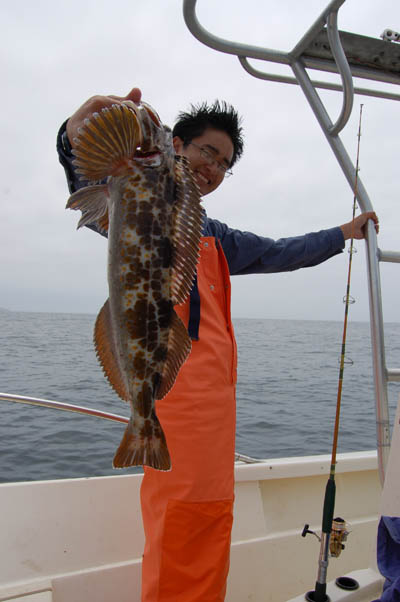
This is the first Ling Cod we got. It was too small, so we tossed it back.
Ling Cods look like giant mutsugoro, but taste much better!
This is Kohei's Ling, which required the use of a gaff to land. It was not so lucky as the first one, and made for a delicious dinner along with the other rockfish that we kept. It had a nasty chomp mark on its flank, likely left by a bigger one. This is one fish whose mouth you don't want to stick your fingers in.
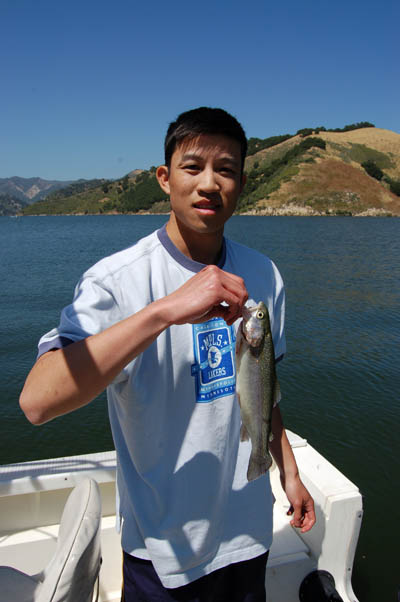
This is Chris' ferocious trout from Lake Lopez, on a trip we took the following day. Sweet!
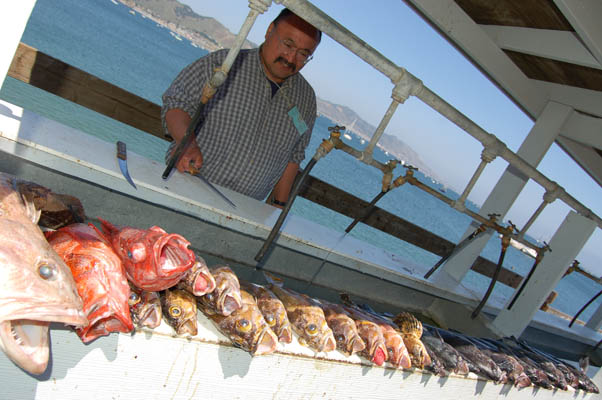
Kohei filleted these suckers in record time, and attracted a medium size crowd in the process. The de-filleted carcasses were quickly snatched up by rival flocks of gulls and pelicans, as well as a sea lion. They started out noisy as all heck, and by the end they were silent, each animal content with their abundance of good fortune. We ended up with well over 20 pounds of fillets!
A view down the mouths of the Ling and a Rock Cod. The rock cods seemed to be eating a lot of juvenile decorator crabs, judging from the stuff that they regurgitated onto the deck.
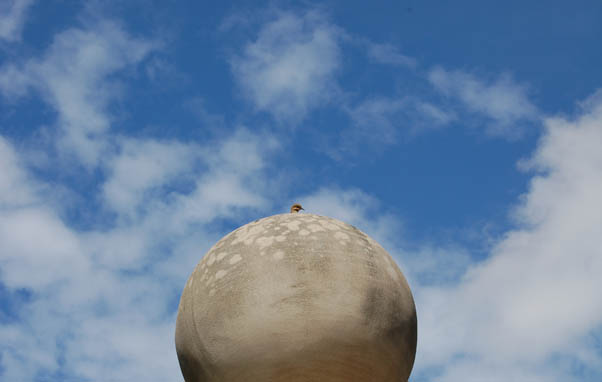
I also took a road trip with my sister and her boyfriend from North Chicago to Orange County in a QX4, loaded full of her stuff. More photos and stories will follow. Never before have I had such a ton of content on the backlog that needs posting. I hope that the pile keeps on growing. Is there such a thing as too much fun and finding the things around you too interesting?
This dude, along with others of his kind, resides at the Marine Center in the southeast of Oita prefecture. This was one of the many places that my dad and I visited on our hectic tour of Kyushu, which I will post more on in the near future.
After a lengthy period of consideration, I've decided to keep posting under the same blog name. Some changes to the site design will have to be made, and I have a ton of content to post.
Justin- nice job on the site overhaul. I don't miss the time consuming process of separating spam from real comments and trackback and using MT Blacklist in tandem with Movable Type several times a day. That was getting tedious.
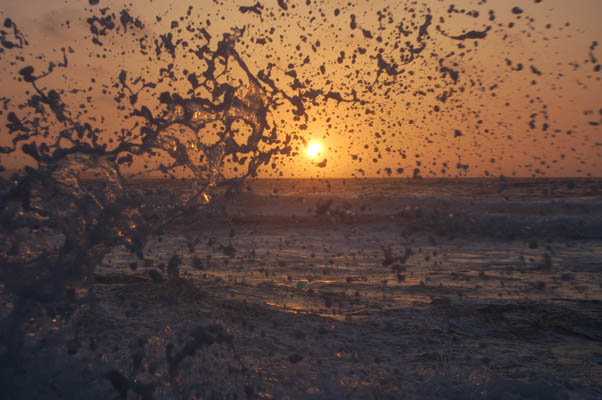
Perched behind a cliff, I thought I was in a good position to get some good shots of waves pounding against the rocks. I was right, but a huge "sleeper wave" sucked the receeding water back, swelled up, and smashed into the cliff, flowing along the contour right at my camera!
My new shoes and pants got soaked, but thankfully my camera was not damaged. I walked away dripping and sandy with a smile on my face, quite aware of just how lucky I was.
I don't think I'll be trying that again anytime soon...
Here are two good articles that you should read:
This one talks about the largest attempted bank heist (in a Sumitomo Mitsui in London) and shady dealings in the growing economies of online games like World of Warcraft, putting everything into context with classic trickery used through out history.
The other one deals with RFID chips, and vulnerabilities inherent in their indiscriminant use. I have to say, I was a little suspicious about my parents' new keyless Prius (it uses a RFID chip in leiu of a mechanical key) and those suspicions have only grown after reading the article.
Wired has a pretty good gallery of Akibahara up here. Taro hit it spot on when he said that Akibake like to hang out at Yodobashi Camera (the one in the picture looks identical to the one in Umeda).
Everyone who goes through Incheon Airport probably has shot these signs already, but...
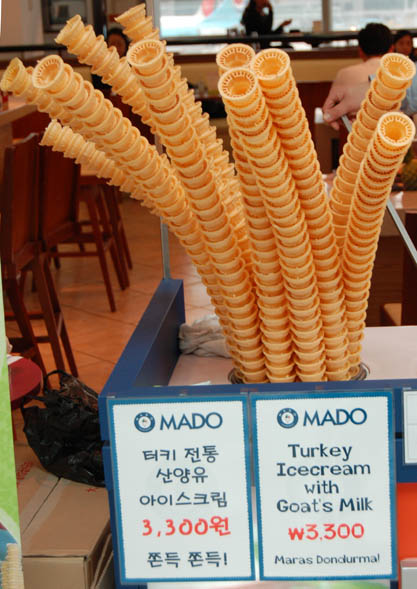
I asked the vendor "Does this ice cream taste good?". When he said "Yes, try some!", I politely declined. If the ice cream wasn't being sold at airport prices, I might have taken him up on it.

Cool. Maybe I'll try it next time.
You can view the set here.
From April 9th to April 16th, my father and I embarked on an eight day tour of Kyushu. We started out in Kumamoto, renting a car at the airport, and then traveled to Saga, Fukuoka, Oita, Miyazaki, Kagoshima, and then we returned to Kumamoto. Along the way, we ate many great meals, but ramen turned out to be the best documented type of food on this trip.
Shirogoma (white sesame) and kurogoma (black sesame) tantanmen are the specialties of one ramenya on the 8th floor of Tsuruya in downtown Kumamoto City. Tantanmen is usually a safe bet to order at any given ramenya in my experience, but these variations proved to be a quite different than the ones that I was used to (for an outstanding tantanmen, try the chain Shisen ramen in Osaka, which can be found in both Minami and Kita- they kick ass!).
The shirogoma tantanmen is much like a common red/white brothed tantanmen, except with less ra-yu (chili oil), and with almost half a cup of white goma sprinkled on top. A large handful of green onions are heaped into the broth for good measure. This tantanmen was good, but I think I prefer the kurogoma tantanmen.
The kurogoma tantanmen is so thick with garlic, black sesame seeds, and seasonings that upon first taste, I didn't think I could eat the whole bowl. My father described the taste accurately when he commented that "it tastes medicinal, and almost unpleasantly strong until you get used to it". It was strange to eat a ramen that started out with such a strong, almost disagreeable taste but got better and better with each bite. If you are trying to get over a cold or a hang over, this bowl of noodles might just do it for you.
The portions were huge, and it was a good place to start on our ramen tour.
Ajisen is one of the two main chains of ramen in Kyushu, the other being Kinryu (not the same as the chains in Kansai). Their ramen is consistently good, and the broth is a solid example of a classic tonkotsu broth. Kinryu, on the other hand, is hit or miss. I have eaten at good franchises and bad one. Of the two, Ajisen is the one you want to visit (It's the one with the cute Chinese girl mascot that kind of looks like Chun-li's baby sister).
Gofu is a Fukuoka based ramenya/yakinikuya. I highly recommend this chain. Their broth is very good, and their charsiu is roasted to perfection. Order the fried garlic as a condiment to make the broth even better!
Although not related to ramen, I thought I?d point out another great Fukuoka based chain called Ichiban dori. This yakitoriya is cheap and delicious. Both Ichibandori and Gofu have expanded North of Kyushu, but it is yet to be seen if they will make it to Kansai (Ichibandori has made it as far as Hiroshima, and Gofu has just gotten started in Shimonoseki). Note: the Ichibandori in Kyoto is not of the same chain, and although delicious, is not quite as good.
This is basically the same as the regular Gofu tonkotsu ramen, except the ingredients are prepared a little differently. The noodles are stir-fried with vegetables and cubed charsiu, kind of like sara champon, but even better in my opinion. My only issue with the sara ramen is that you can't get kaidama because there would be no broth left to put it into.
Kokutei is perhaps the most famous ramenya in Kumamoto, but despite living here for two years, this was my first visit. Hieda sensei led us to this gem, and it was packed full of customers with a line of people waiting to get in (out of the rain). The charsiu was decent, but the best part about this ramen was the broth. Rich and creamy, like a good tonkotsu should be, it was full of roasted garlic and required no additional seasonings at all. It was perfectly balanced.
I love eating ramen in Kyushu because it is ramen mecca. You can walk into a ramenya anywhere in Kyushu and be confident that the ramen isn't going to suck. There are many places that serve good ramen down in Kyushu, but we only had time to stop into a few of them. Perhaps one day I will return and make a complete evaluation of the ramen of Kyushu?
Some random thoughts about ramen:
*The stinkier the ramenya, the better the broth.
*Kaidama (a noodle refill) kicks ass, but is hard to find outside of Kyushu.
*Kaidama was not available at the tantanmen restaraunt or at ajisen, which was kind of disappointing.
*Broth conservation is something one must keep in mind when ordering kaidama is a possibility.
*At Gofu, they will reheat your broth (and add a bit more) if you order kaidama!
*My friend Matt once asked for kintama (testicles) instead of kaidama at a ramenya.
*Some people believe that translating "ramen" as "chinese noodle soup" makes it easier for foreigners to understand, when in fact just saying "ramen" would be less confusing in the first place.
*Is there ramen in China? If so do they just call it "noodle soup"?
*My top 5 toppings are charsiu, boiled egg, roasted garlic, bean sprouts, and green onions.
*If kaidama is available, then a side of rice or onigiri is unnecessary.
*"Fusion" ramen that mixes the theme from another country's culinary style or ingredients is usually not very good.
*The only good "ramen stadium" I have been to is in Canal City, Fukuoka. The one in Namba is disappointing.
*Bikkuriramen's ramen is not bad, actually.
*I have a friend who talked the manager of a Bikkuriramen into giving her a discount on a bowl of ramen (Bikkuriramen is a chain famous for selling ridiculously cheap ramen).
*Instant ramen mixed with hot dogs, kimchee, and eggs is a great combination!
*Ramen is great after a night of drinking, but seldom is satisfying as a stand-alone meal.
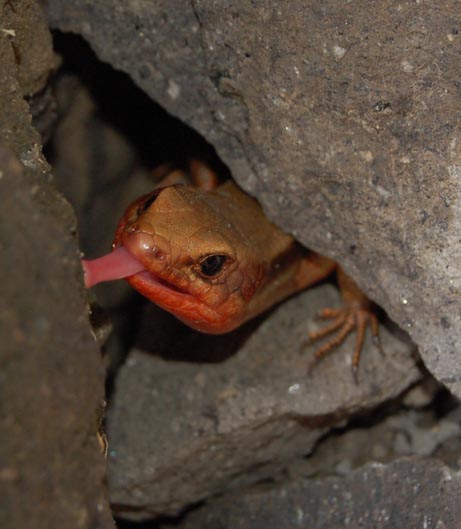
A Japanese skink in between the cracks of the foundation of the ruins of Usuki Castle (Oita Prefecture). Unlike most skinks in Japan, this one lacks the rainbow stripes against the black body. He was running away when I took his picture, but I guess he wasn't worried enough to pass up a meal.
As I still have a decent amount of material about Japan that I have yet to post, I plan on running this blog until I exhaust my reserves. After that, I haven't decided whether or not to maintain it as a static archive or to keep on posting. In any case, I have some time to mull this over before I make a decision.
Regarding the material: I need to prep the computer that I'm using before I can install Photoshop and work on my pictures and that may take some time. Once that's done I need to review the few hundred photos that I took during my last days in Kyushu. I'll should get started on this by some time tomorrow if all goes according to plan...
I'm in an internet cafe in an airport in Korea, and I feel disembodied. My keitai no longer works, my apartment is as clean as the day it was first constructed, and I have turned in my gaijin card. There is no changing my mind now. Leaving Japan feels like I'm leaving home. Going back to Southern California feels like I'm on my way to vacation to an old favorite destination.
I have had the time of my life in Japan since I arrived three and a half years ago. Meeting new friends and family while exploring the culture, language, cuisine, and areas of Japan has truly been a non-stop adventure. I know that I am truly fortunate to experience everything I have been able to over here.
So what now? I still haven't decided what to do when I go back, and I am thinking that I might want to teach at a University in Japan in the future. For now, the plans are to go get a big carne asada burrito and go get a tan at the beach.
Japan, this isn't a goodbye just yet...
link (via Gorilla Mask via Warm Milk Comics)
There's something to be said for small pictures taken with a cell phone. The first cameras on mobile phones were nothing more than toys, but I was able to get a lot out of my Mitsubishi D251 before it finally lost its picture taking capabilities. I actually preferred this model to its predecessor, the sleeker looking D253. The later model Mitsubishi took higher resolution pictures, but it lacks a removable memory stick and has no flash!
The following pictures are a chronicles of my time on the JET Program, when I was living in Ubuyama-mura (in Kumamoto prefecture). As you might be able to tell from this photostream, my life has been a non-stop procession of fun and adventure.
Today was the last day of work for some of us in the office, and to commemorate this occasion I am posting Huw's "Countries of the World" flashcards. The flashcards are appropriate for elementary school level students, however, the spoofs are obviously not meant for anything other than entertainment value.
If you are easily offended by inflated stereotypes about countries, then you might not want to waste of your time looking at these. However, if you have ever taught English in Japan and have an irreverent sense of humor, I think you might be able to appreciate these. Huw sincerely hopes that he has done everything that he could to offend everyone equally... Enjoy!
Question 1
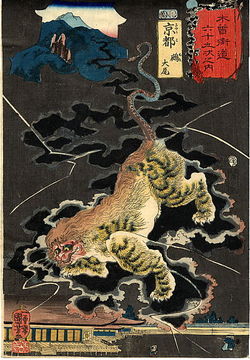
What has the head of a monkey, the body of a tanuki, the legs of a tiger, and the tail of a snake?
Hint #1: Eating it is thought to cure the hiccups (I wonder what it tastes like and how it is prepared. I imagine it would make a decent miso-based nabe...).
Hint #2: Miyamoto Musashi supposedly killed one of these with a lance.
answer
Question 2
This mythical creature is native to mountain passes in Kumamoto. What is it?
Hint #1: They have a potato-like head (or a stone one), and a straw covered body.
Hint #2: Monks who stole oil are said to have been punished by being transformed into one of these.
Question 3
This monster is a humanoid with blackish-green skin, luminescent eyes, and a pointed beard. It is rarely seen by man because it lives in an underwater kingdom.
Hint #1: Combine the kanji for "shark" and "person" to make this.
Question 4
What is the Japanese Will 'o the Wisp?
Hint #1: A possible explanation for these phenomena is methane gas rising from the graves of decomposing corpses.
Hint #2: Combine the kanji for "ball" and "person".
Question 5
What mythological creature resembles a snake, can speak to humans (but often lies), enjoys alcoholic beverages, can leap 1 meter, and has never been captured in spite of many reported sightings?
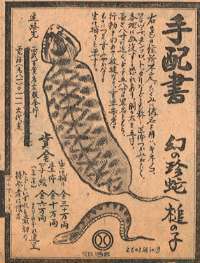
Hint #1: It appeared in Doraemon, where it was reported to be about 60cm in length.
Hint #2: The kanji for earth and child are used to write its name.
In Umeda, demolition and construction are an ongoning process, like birth and death. Cranes stretch towards the skyline like a pod of brotosaurus on the plains of our primordial Earth. Come to think of it, the planes flying towards Osaka airport kind of look like archeopteri...
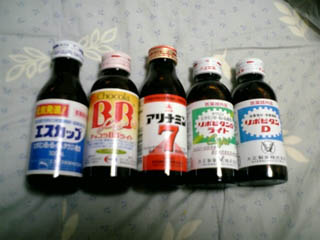
Taro bought me an assortment of energy drinks/vitamin elixers. I'm thinking of drinking them all in one go...
I used to think that mixing energy drinks and spirits would be a good idea, but this is not true. Though it often makes for nights charged full of fun and great stories, the events of a night involving this combination usually involve life-threatening situations or temporary loss of memory. The synergetic results are not a good idea under the best of circumstances.
Genki drinks by themselves can do wonders though. One time, I was sick with diarrhea and vomiting while riding the bus up to Hiroshima to go snowboarding with a bunch of friends. I woke up exhausted and deeply disappointed, questioning my ability to snowboard that day.
I crawled out of the bus and bought 3 genki drinks, downing them in quick succession, followed by a tuna mayo onigiri. Thanks to this combination I regained my strength and was able to board with no problem all day.
So what will I do with these genki drinks? I don't know just yet, but I plan on using them in a medicinal context. Sometimes not having interesting stories is a good thing.
Work finishes on Friday! Most people seem a bit more cheerful in the office now that the end is near, and this weekend should be a good time to celebrate this milestone with a party under the cherry blossoms. I may decide to go out even if it rains (a hanami party in the rain is truly underrated).
I've been in Japan for so long that I feel as comfortable over here as I did back at home. In spite of this, I've decided to return to Southern California. It will be nice to connect with old friends and relatives, and I am in dire need of a tan. The Japanese winter makes one pastier than a Canadian!
I wouldn't mind living in Japan, and in fact, it's still an option. However, if I were to do so, I wouldn't want to continue being an ALT. Should I choose this path, I would first get my masters and then teach at a university.
As far as I can tell, the eikaiwa market (along with contracts for ALTs in the public school system) is slowly but steadily declining in regards to the quality of services provided and salary and benefits offered. If you are on the JET program, you are doing much better comparatively than those who came before you. If you are teaching in Japan and planning on staying, I highly recommend applying for JET (best-case scenario) so you don't have to go through the hassle of working for a company (better-case scenario), a private or corporate eikaiwa company (worse-case scenario), or one of those notorious companies that have a high turnover rate of gaijin fresh off the plane (the worst-case scenario).
I'm planning on leaving on the 18th of April, but before that I will be taking a week long trip with my father around Kyushu. It will be nice to visit southern Japan again, the place that I consider my home away from home.
It will be nice to see everyone when I get back. See you soon!
These stickers are made by Japanese Tobacco (JT), who also runs a salt and tobacco museum up in Tokyo.
A few ads from a bygone era:
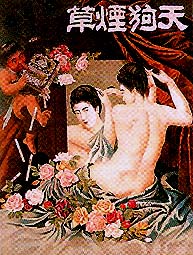
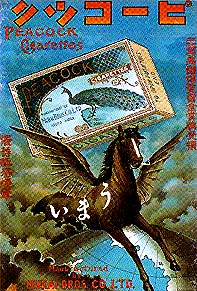
(from here)
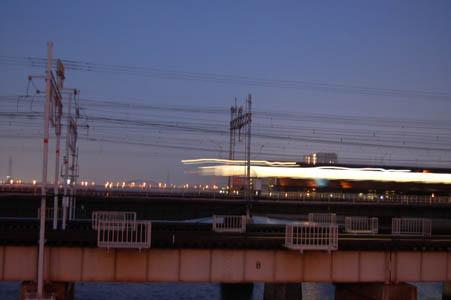
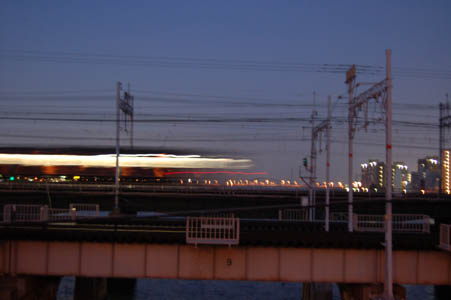
I need a tripod!
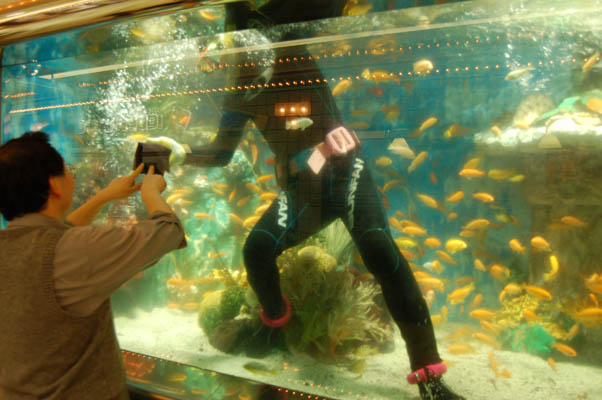
At first, I thought that the diver and his spotter were performing some sort of perfomance art, and they kind of were. Amazingly, no one stopped to watch him except for me.
This guy also has to jump into tanks with giant Amazon catfish, sharks, and cichlids. It amuses me that the colorful ciclid tank likely poses the greatest risk to this diver (though it wouldn't be amusing if any harm actually did come to him).
Friend of mine just lit a cigarette on my stove, and he got too close to the flame. Hair still smoking, he asked "Oh, what happened?". Now it stinks like burnt ass in my mini kitchen.
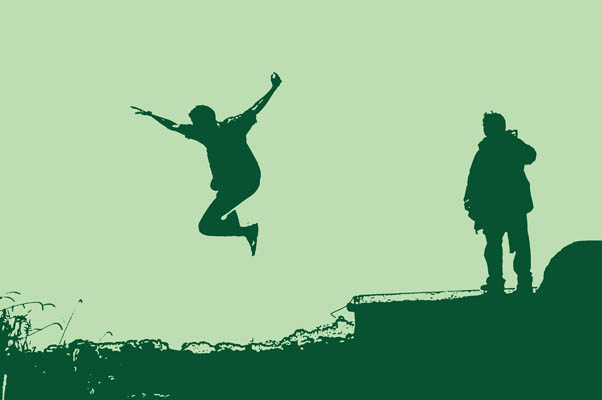
(Original picture courtesy of Justin)
This is dedicated to a fun, 3 hour hike in the rain with Justin and Taro, followed by a night of kushikatsu, drinking, karaoke, and onsening in Nara.
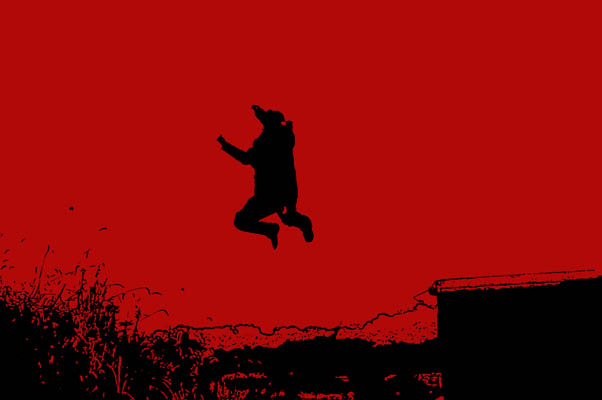
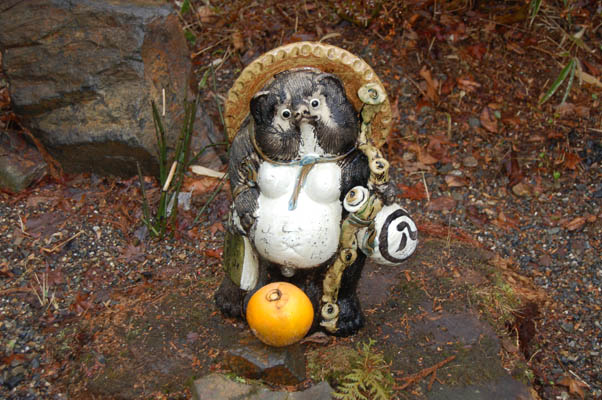
Ponpoko pon no pon is the onomotopoetic Japanese expression of how tanuki move. When I saw one running, I was impressed by the accuracy of which ponpoko pon no pon captures their wobbly gait.
Known erroneously as a "badger" or "raccoon" and more accurately as a "raccoon-dog", Tanuki is the only word that fits this animal. The same goes for words like sushi, ramen (translated as Chinese noodle soup), tsukemono (Japanese pickles), miso (fermented soy bean paste), or samurai. The English translation takes something away from the native word by giving an unsatisfactory description.
Apparently, some people eat tanuki in the more rural areas. One of my brother?s friends from Tenri Daigaku described the meat as being gamy and tough. She said that a friend of her family came by the house and dropped off a parcel of meat, which they prepared in a miso-based broth. Miso, it was explained, is a good complementary base to use with gamy meat.
One of my friend?s grandfathers, who lives in Kita-Kyushu, is an avid huntsman. He regularly shoots tanuki but only keeps the fur. His daugher, my friend?s mother, makes the pelts into hats and other rustic clothing, which I like to think he wears on his hunting trips.
Recently I watched an excellent animation produced by Miyazaki Hayao called 平成狸合戦ぽんぽこ(Heisei Tanuki Gassen Ponpoko). At first glance I didn?t expect this anime to be anything that I would be interested in, but it actually deals with such serious issues as social, economic, and environmental problems, the chief one being urban sprawl in the Kanto region of Japan. I highly recommend this film to anyone who is interested in Japanese culture, folklore, or history, as it is bursting full of references to almost everything you can think of.
One thing that still alludes me about the tanuki is why udon with age on top is called tanuki udon, while putting this on top of soba makes it kitsune udon. Does anyone know anything about the history or lore dealing about these two popular meals?
It sucks to see pets being crammed together like this, warmed like chicken karaage under intense heat lamps.
Unfortunately, pet stores like this seem to be pretty successful. There are some humane society-like organizations, but they are not nearly as big or powerful as they are back in the states. Only in places like Ashiya have I ever seen pets up for adoption.
Walking down one of the many shotengai in Shinsaibashi, my brother points to a well-known pet store flanked by a pachinko parlor and a mom and pop store that?s been closed up for the night. ?That place got raided by the cops a few years ago. Thy got busted for keeping a tiger and other endangered animals in the back room.? he says. Yakuza like to keep such animals in their apartments to show off, supposedly.
The first thing you?re probably thinking when you look at these pictures is likely to be something like ?Look at the poor little furry animals! That?s so cruel!?
And I would agree with you. Puppies being abandoned in the wilderness or tortured for amusement, newborn kittens tossed into drainage systems during a rainstorm, toads being ripped apart by over-excited little boys, frogs getting blown up with firecrackers (some of these don't count as pets, but illustrate the sadistic pleasure that some people get from torturing or destroying animals in general). Pets are neglected and waste away. It?s normal to see these things over here, but that's only the most visible aspect of this subject.
But I would argue that most Japanese pets are treated like part of the family and are very well taken care of. It should be noted that many people that I know who take care of their pets properly either get them as part of a litter of a friend's pet, or rescue them from a dire situation.
For those owners that keep their pets in tiny enclosed areas, I would argue that many would not consider this cruel. Many people in the city live their lives under similar (but admittedly different) circumstances. If you lived your whole life in a tiny apartment and spent every working day in a cramped office, you might not see anything wrong with keeping your pet in a similar environment. Master and pet, sharing the gaman.
Surprisingly, I think that the dogs of the homeless people live the best lives of all pets in Japan on average. They look the happiest, and seem to be well taken care of. Most homeless rely on their dogs to guard their possessions and property. They are valued companions. They also enjoy a greater degree of freedom than pets owned by people with houses, as they often get to play and hang out with other whenever they like.
If you walk along the Yodogawa, you will see improvised tombstones, bearing names like Kuro and Chibi. These weren?t just dogs, they truly were part of the family.
I'm not writing about anything especially interesting or though provoking. This is simply about an average day in the office over here.
It?s one degree outside. That?s what the screen on the wall-mounted air conditioner reads, but it doesn?t feel that bad once I get in the shower. Letting it run for 5 minutes makes the steam gush out when the door is opened, and it blankets everything in my compact bathroom with a thick coat of mist.
Though I?ve been awake for 50 minutes and acclimated to the light in my apartment, the glare of this clear day pierces my optic nerve like needles when I step out. It?s bitter cold, and the wind whips up whitecaps as far as you can see down the Yodogawa. The wakeboarder isn?t out this morning, and all of the homeless are still tucked away in their blue plastic homes.
There?s something nice about taking the trains around Osaka at off-peak times. No one invades your personal space, and it?s even kind of cozy. People watching kills most of the time on the commute from Kita to Minami.
I notice something new everyday coming and going to work. It?s surprising how much changes from day to day and how many things have escaped my notice over the course of a year. There?s a new Family Mart being built across the street from what used to be the 7-eleven (but is now the i7 and Holdings) that I occasionally drop in to grab breakfast.
I?m amused to find myself excited about the prospect of being able to access a convenience store that?s 100 feet closer to work.
The ancient laptops stutter-hum like semi in the summer heat. I?m living in a world of floppy disks and Windows ME, grateful that these dinosaurs even have USB ports. Just yesterday, one of the hard drives died. We started out with seven laptops. We?re down to three now, as one by one they succumb to the ravages of time.
The cold, hard fluorescent lights that bathe everything in the office in a sickly tint are losing their grip. The spring sun is filtering in through the windows, and the cherry blossoms are preparing for another hanami. Just a little bit longer, and I?m out of here?
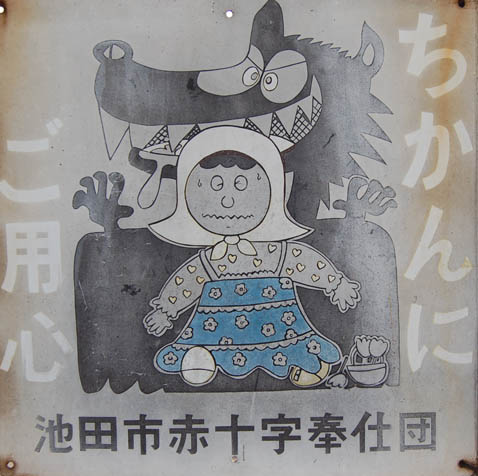
A wolf preying upon an obatallion.
The red circle is the sun goddess Amaterasu. It is the rising sun on the Japanese flag. It is Zen. It is an amazupai umeboshi. It is beautiful in its simplicity. Sadly, it is no longer used by Japan Airlines.
Back when airplane food truly sucked, when they still handed out packs of honey-roasted peanuts along with mini-decks of playing cards, and when I used to be able to sneak into first class with my sisters, JAL had the best logo of all of the airlines. Riding a plane with the tsuru mark made even the flight over to Japan seem exotic. It was a graceful metaphor for the Boeing which was carrying us to an exciting foreign land.
As I remember, JAL had some of the most beautiful and nice stewardesses that I can remember. They often turned a blind eye to us when we snuck up to the first class seats. Only once, when a grumpy old man protested to the stewardess were we (nicely) turned back to our seats.
Who made the decision to get rid of the tsuru, a symbol that conjures nostalgic images of Japan for a corporate logo? If I were the president of JAL, that dude would be so fired.
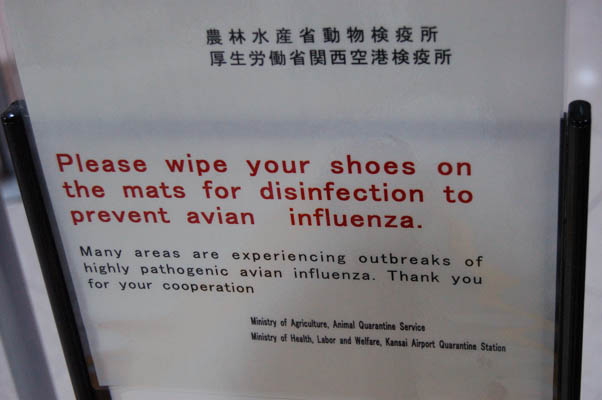
What can these mats really do make sure that avian influenza doesn't enter the country? I think they're there just to make everyone feel better, kind of like making people wait two hours to pass through security when you go to LAX makes us feel safer. Because they're special mats!
When you return overseas to work in Japan, why not have some fun with it or milk a little vacation? Pretend to sneeze, wipe your hand on your pants, and then shake hands with people when you arrive. Talk to them about how much you loved the local delicacy, pigeon sashimi, when you visited the country regions of any place tht has been in the news regarding avian flu outbreaks. Every so often, let out a muffled cough towards your victim and cover your mouth with a few gaps between your fingers (Note: if you do this, you run the risk of being labeled an a**hole, and you really shouldn't be doing this if you really are sick).
If you are on the JET program, this should be a sure-fire way to get you some extra "vacation" (they'll likely quarantine you for a week). It happened three years ago with the SARS outbreak, resulting in a Kumamoto-ken-wide quarantine of JETs who had traveled abroad during the heights of the scare. Everyone, except for me, that is. Even though I came back to Japan with a cold and a severe case of southeast asian microorganisms not agreeing with my digestive system. Actually, I was glad to get back to work, and quite thankful that they didn't make me go in to a lab to be tested by paranoid government workers. That would have sucked!
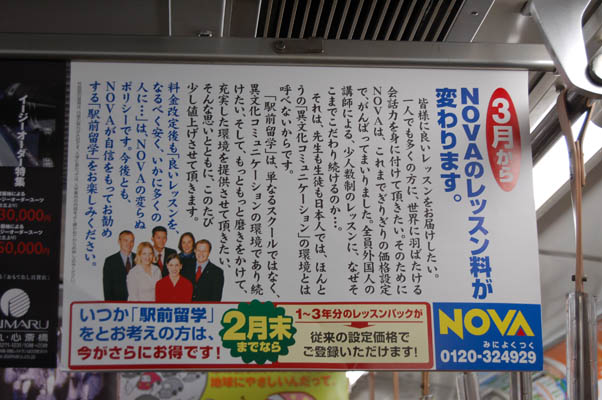
The gist of this advertisement is that Nova is going to raise their prices and ostensibly their level of service as well. We all know this is BS. I have met some pretty cool people that have worked at all of the main eikaiwa companies in Japan including Nova, but Nova seems to attract a lot of sub-par, loser gaijin while offering second-rate english conversation lessons. Nothing is very likely to change, except for a price hike.
This has to be one of the stupidest advertisements I have ever seen. Who should have to pay more for an already over-priced, inferior service? Unfortunately, it isn't common knowledge to Japanese people that Nova isn't one of the better franchises. Marketing does work, but will people really buy this?
To their credit though, Nova is a good for getting you a working visa in Japan, for generating unbelievably funny baka-gaijin stories in bulk, and sometimes for networking. Other than that, it is a company that regularly passes out packets of tissue paper for free at most of the places heavily used by pedestrians in Osaka.
Working with first year primary school students is a lot like being a sheet of tissue paper. The kids seem to enjoy wiping, throwing, spilling or somehow conveying dirt, food, saliva, beverages, and other stuff that would make a petri dish bloom with a thick fuzz ranging the full spectrum of the rainbow.
Today a few kids insisted on licking my sweater, tried to kancho me (swift and merciless revenge was exacted, and the little demon-spawn thought twice before approaching this gaijin with anything other than good intentions), and this one, well, he did something that took me off guard..
During lunch at shogakko, the children push their desks into groups of 4 and each day, they take turns at donning scrubs and masks and serving the school lunch. I am usually shown to a seat, and spend my time playing with them or talking to them about whatever they're interested in that particular moment.
This kid was asking me some questions when he started digging around his nose and pulled out a choice nugget. Fascinated, he decided to test its viscosity by repeatedly poking it against a chair and stretching it out. It was quite sticky and stretchy, like the cheese that strings off of a freshly baked pizza. After a minute, he decided to roll it around the table, as if kneading a lump of dough.
Then he caught me watching, and I could see the light bulb blink on behind his dark, evil eyes. There was never any doubt of what he planned to do, and we locked eyes like rival samurai in the midst of a battle. He extended his loaded finger, this loathsome bayonet of terror, and charged. As I caught his hand, I pulled out my keitai with my other one and switched on the camera.
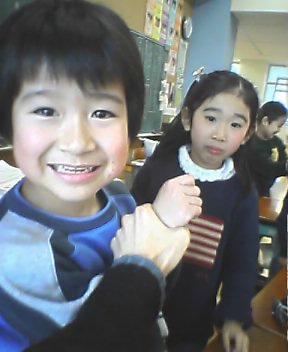
"Wow, that's a great booger, do you mind if I take a picture?", I asked. His puny 6 year old brain was short-circuited by the sight of a camera and my question, much the same way a magician uses his props to draw attention away from what he doesn?t want people to see, and he forgot about his wicked deed, reprogrammed by the desire to be photographed. The other kids, of course, then screamed to have their pictures taken as well, and I obliged them, grateful to pay this price instead of having some little brat's booger smeared into my clothing.
So if you teach at elementary or nursery school, remember the camera on your cell phone. Properly used, you can easily change your fate by using it to misdirect the little bastards! Just remember to lock the keys on the phone just in case one of them manages to swipe it from you.
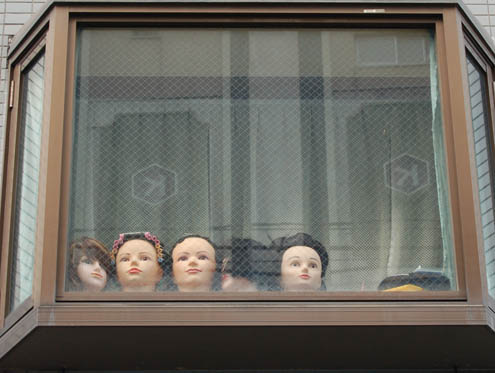
How would you like to open up the curtains and see this from the window of your love hotel? It would serve you right for being such a tight wad and picking that hotel in the first place! This was found, of course, in Juso.
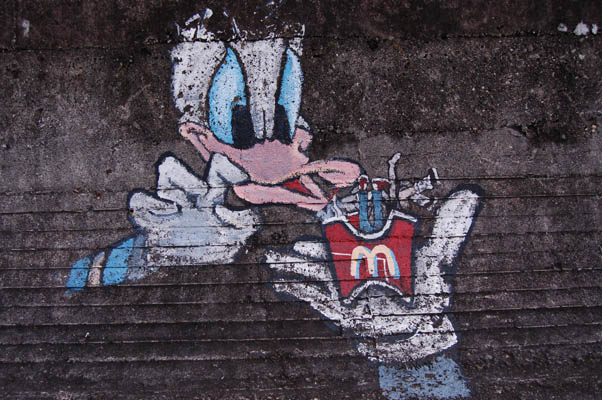
Donald Duck enjoys a little something from McDonalds. Take a careful look at the fries. Another thing to consider: Who is proffering him the fries?
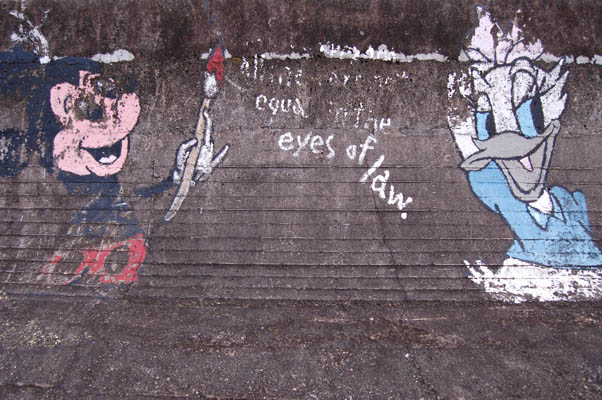
"All men are not equal in the eyes of law."
Sounds like something that Hammurabi would say.
These Disney characters are really starting to creep me out.
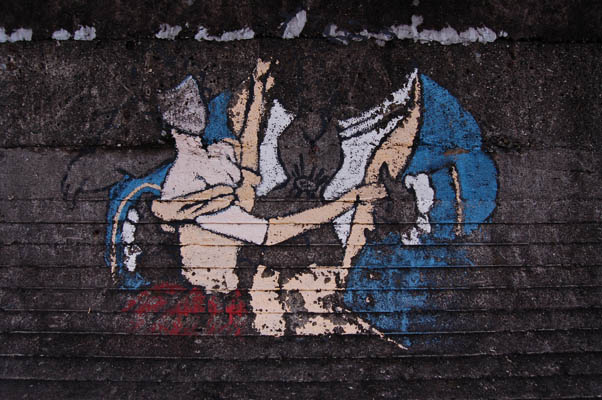
Beauty's face is missing and the Beast has gone invisible.
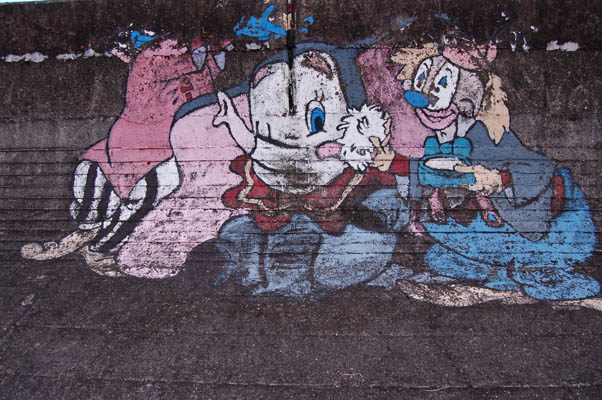
Dumbo wears as much makeup as some of my students and, sadly, this is hardly exaggeration.
Surprisingly, this place isn't in Juso.
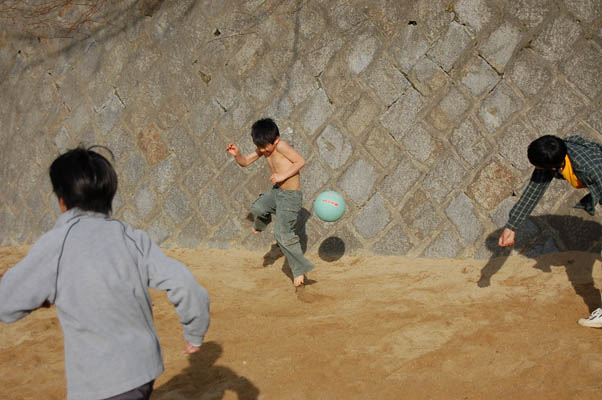
This kid was playing dodgeball shirtless on a day that was cold enough to snow. He insisted that "hadaka power" gave him special powers. Ah, I'm going to miss the dodgeball.
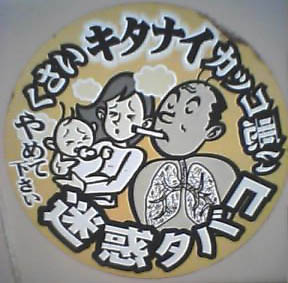
This sticker expresses my exact sentiments towards tobacco smoke and inconsiderate smokers. Wanna smoke? Hey, that's your right, but keep it out of my face!
This is the view from the Umeda Sky Building, which overlooks all of Kita, as well as Yodogawa-ku. At a higher resolution, you can see the tents of the homeless that run along the sides of the Yodogawa.
Apparently, there is going to be a big, important rose festival and an event showcasing urban greenery (English link) in Osaka later this year. The city officials want to get rid of the homeless in Osakajo park and Utsubo park, where these events are to be held. In order to dismantle the 28 homes in the park and to evict their occupants, about 1,100 workers, security guards, and police were sent in to do the job. Understandably, the homeless and their supporters did not go willingly.
Osaka homeless resist police move (from the BBC, thanks Huw)
Here's an article of information about the evictions in specific, and the challenges faced by the Osaka homeless in general (if you only read one article in this post, read this one):
Urgent appeal from Homeless activists in Osaka, Japan
In this article, the Kamagasaki Patrol no Kai also gives the reader information about what is being done to protest the government.
I think it?s pretty fucking cold-blooded that the city authorities have decided to evict the homeless in the middle of this brutal winter. These are not people who can just pack up and move easily, even when it?s not freezing. I would feel pretty guilty about going to this rose show, knowing that part of the price of admission was paid by people who got kicked out of their homes!
This reminds me of an urban planning class I took at UCSB, when the professor showed us pictures of public benches in cities around America and asked what all of them had in common. ?They?re all designed so that homeless people can?t sleep on them. Next time you?re out and about, look at the designs of the places of the seats.?, he said.
And sure enough, they?re all over the place. Seats are slotted, molded, and partitioned so that you can?t lie across them and benches are curved in a convex contour so that if you were to lie them you would fall off. It?s the ultimate passive aggressive design and it?s invisible to everyone except for it?s targets.
Another article reports a case that may set precedence, for the homeless to be officially allowed to live in the public parks. The Osaka district court recently overruled the Osaka Kita Ward?s decision to reject one homeless man?s registration of his tent in a public park as his address of residence:
"I'm surprised and happy because I did not think I could win," Yamauchi said after hearing the verdict.
"If the ruling is finalized, I plan on applying for welfare," he said.
Yamauchi's lawyer said a person cannot exercise the right to vote or receive welfare, including pension and health insurance, without a residential registration, which means he cannot lead a decent life as a citizen.
(Park deemed tent man's valid address, from the Japan Times via Justin)
I had no idea about the size of the homeless population in Japan, but the BBC article listed a figure of 25,000 people, with a third of them living in Osaka. Apparently, the poor economic performance over the last 15 years has spurred a growth in this demographic.
The homeless around my area maintain gardens, and live a much more sustainable lifestyle than you or I or any average person. The goal of using open green spaces is to create an environment where we can go to feel comfortable, to decompress after spending the majority of our day in a building, surrounded by glass, veneer, cement, bricks, concrete, and barriers that keep us separated from others in general. Urban planners like Frank Lloyd Wright used these areas to help bring nature into an environment that has been sterilized of it, as a place to allow people to enjoy the outdoors together in these commons.
The city officials are kicking out the very people who are living more at harmony with the landscape and urban environment than any other segment of the population. I wonder if they have ever though about where all the trash in the parks comes from, and what demographic abuses the commons the most. Can you guess where the bulk of the garbage next to the Yodogawa comes from?
It comes from people who visit it on the weekends, from upstream, from those damn teenagers and salarymen who eat their convenience store bought snacks and cigarettes and don?t bother looking for a trashcan, and from people who illegally dump their waste on park grounds in order to avoid paying a disposal fee.
It?s the homeless people, the ones who live in these commons, who pick up after the visitors after they go home. It?s the homeless people who ?Reduce, Recycle, and Reuse? other people?s refuse to make or maintain their shelters. Hell, the homeless even maintain extensive flower beds next to the Yodogawa, adding color to an otherwise unremarkable patches of land.
The best way to get a feeling for how remarkable a life that these people live is to go out and visit these places, and that?s just what Justin, Nam, and I did this weekend. We walked along the Yodogawa and checked out some of the tents up close:
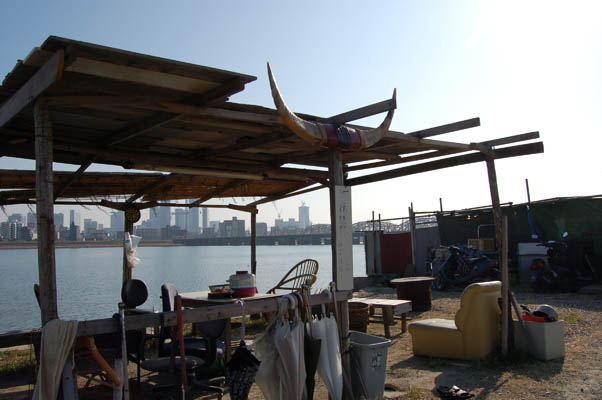
(click on picture for a close-up of the sign, photo by J. Yoshida)
This is an awesome outdoor space that some homeless dude set up next to his tent. The sign says that anyone can use this area! It?s funny how we, the ones with money and property, post signs to drive people away. I might just throw a barbecue party here before I leave, no joke.
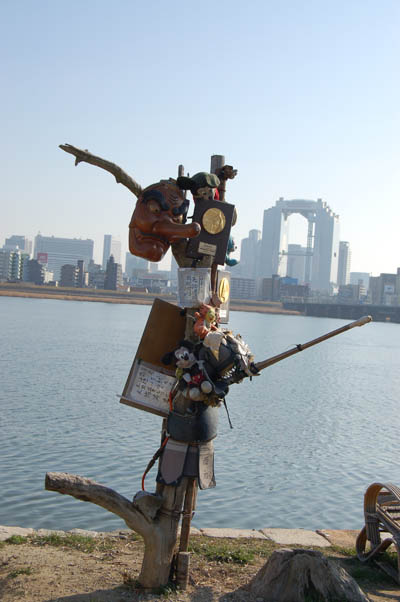
An example of inner city beautification, not paid for by Japanese tax dollars.

(photo by J. Yoshida)
The homeless make use of all available materials. They also seem to own their own boats!
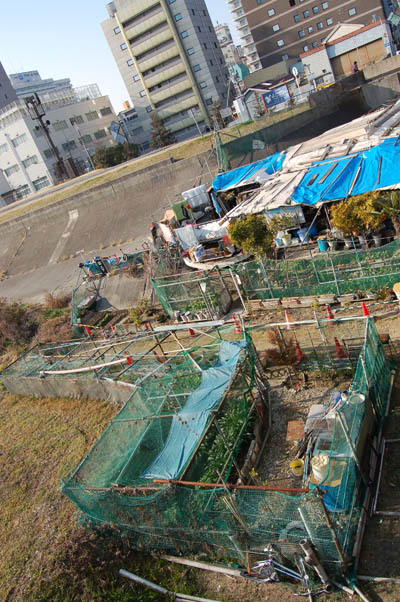
These (private) gardens are meticulously maintained, and it looks like leeks, onions, lettuce, and other leafy vegetables will be on the menu this winter. This dude puts the UCSB Environmental Studies major hippie communes/cooperatives to shame! This is sustainability. Did I mention that they sell fishing bait here as well?
As I mentioned before, I will be posting more pictures on my Flickr page so check back once in a while for updates.
Also, I was wondering, is there any other way besides 家のない (ie no nai, or without a house) and安息の場を与えない (ansoku no jou no ataenai, or without a place to rest) to say ?homeless?? Was there a time when saying these words required more of an explanation if you used them in a conversation? Surely a loanword will come into use as the homeless population and issues dealing with them continue to grow. Or maybe not. After researching this topic more thoroughly, it looks like the same things happen and are breifly reported in the news year after year with nothing much changing. Homeless will likely stay "a person without a home" because no one wants to think about them, let alone deal with the problem.
Further Reading
Shannon Higgins tells the story of Japan's largest slum in The Kamagasaki Gallery
Oyama Shiro's book A MAN WITH NO TALENTS: Memoirs of a Tokyo Day Laborer
The Streets of Osaka as documented by subjectivite.net
An excellent BBC pictorial on Japan's homeless, with interviews
This article by the Cristian Science Monitor explores the link between ageism and the homeless in Japan
Artist Geoff Reed's Face The Street
Andreas Seibert's photos of the homeless in Osaka
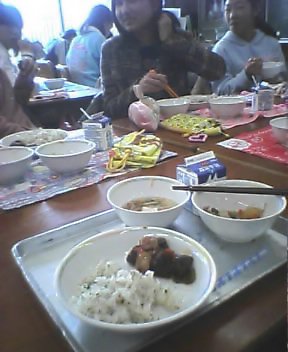
I?ve been lucky to have been stationed at schools that have their own cooking facilities on school grounds, so everything has been freshly made. As a bonus, kyushoku is cheap (220 yen for a lunch at my current school), and seconds are often available for those who want more.
The task of serving school lunch is delegated to the students, who carefully portion out the food. At the end of the designated time that they are allotted to prepare lunch, a student reads off the menu so that every one can check to make sure that they have everything that's supposed to be there and also to let every one know just what it is that they will be eating.
On this day, I was talking to my students and ignoring the announcement when I heard ?blah blah blah?kujira?blah blah?, and took a second look at the sweet and sour ?pork?. I tasted it, and it was almost identical to the generic sweet and sour pork that you can get at any Chinese restaurant, except the meat wasn?t as fatty. Although delicious, this particular kyushoku made me agitated.
Why would you use whale meat to make a dish that tastes better with pork anyways? Whale meat is certainly more expensive than pork, and there must be other ways to prepare it so that you know you?re eating whale. It just seems like such a waste, even if you ignore the ethical implications of eating large marine mammals. The whalers went through a lot of trouble to file the paperwork to harvest the whale for ?scientific research purposes? and to harpoon the damn thing, so why did they make the whale taste like pork?
Another thing bothered me about the whale. I didn?t feel bad. At all. I chewed it, and though images of Greenpeace, mortally wounded whales floating on a patch of red brine, and other things passed through my mind, it didn?t make me disturbed in the least. All I could think was, ?Wow, this tastes like a lean cut of pork?.
I was curious to know where this whale was from and what type of whale it was. What species was it? Was it a toothed whale or a baleen whale? Where was it caught? How was it captured? The sad thing is that no one ever knows where the whale for our school lunches comes from. They know more about the beef, milk, and vegetables than the whale!
Friday night started out with a trip to go buy enough gyoza for 6 people, meaning 36 garlic stuffed pot stickers, and five tall cans of premium Japanese beer. Once in a while, Osho has a half-price sale on gyoza and people line up outside in a long queue, braving the elements to secure these much-coveted snacks.
I had seen the 105 yen (half price) for a six pack of gyoza advertisements since I've been in Juso, but this is the first time that I actually went out and bought some. Even with two people, it was difficult to make it through all of the gyoza but we managed.
Next week, there's another sale on Saturday so if you're around, please let's enjoy beer and gyoza party in Juso!
Mark has a nostalgic post about Kumamoto, along with a nice spread of pictures to illustrate what life on JET was like during our stay (and what it will probably be like for many years to come).
It got me thinking about what a great time I had down there. It's hard to organize the things that I've seen and done down there. This is the most clear and concise way that I could think of quickly cataloguing my experiences:
The Kumamoto Top 5s
Top 5 Hikes
1. Kuju during the winter and spring
2. Aso-san at night
3. Kikuchi gorge
4. Yamabuki suigen when the fireflies are out/ Yamabuki suigen with fresh snow
5. Daikanbo on the Milk Road
Top 5 near death experiences
1. Playing with mamushi
2. Mark getting guillotined by Deez Nuts
3. Driving the Milk late at night in thick fog
4. Driving without a blinker due to Dukes of Hazard entry gone wrong
5. Almost driving off a cliff in Ashikita with Deez Nuts
Top 5 parties
1. Jason's house on any given weekend during the first year
2. Hanami at Kumamoto Castle
3. Waterwheel
4. Any night after a hash
5. Hanami in Ubuyama
Top 5 excuses to get out of work
1. SARS
2. Tori influenza
3. Buying teaching materials
4. Going to a "meeting"
5. A byoukyu surplus
Top 5 perks of JET
1. Recontracting conference in Kobe
2. Mid-year conference in Kumamoto City
3. Free Japanese lessons
4. Loads of nenkyu, raikyu, and byoukyu
5. Meeting cool people from all over and making fun of NOVA people (haha, those guys suck!)
Top 5 foods
1. Tonkotsu ramen
2. Basashi
3. Masa's hamburgers
4. Iseebi sashimi
5. Karashi renkon
5 things I never ate in Kumamoto
1. Inoshishi
2. Kuma
3. Kiji
4. Koi zushi
5. Mamushi
Nastiest 5 drinks
1. Anything from the Sanctuary Bar
2. Flaming doctor peppers
3. Jack Daniels and Contac cold medicine
4. Cheap straight shochu
5. Old, warm happoshu
Top 5 surrounding prefectures and their best attraction
1. Fukuoka- Fukuoka city
2. Saga- Nanayama-mura
3. Miyazaki- The gorge
4. Kagoshima- hiking Kaimon-dake
5. Oita- the aincent Buddhas
Top 5 Onsen Spots
1. Kurokawa
2. Ashikita
3. Ubuyama
4. Kikuchi
5. Kumaden plaza's rooftop onsen
Top 5 menacing/disgusting animals
1. Mamushi
2. Mukade
3. Gejigeji
4. Ao mimizu
5. Roadkill (tanuki, itachi, dogs, cats, and snakes)
Top 5 animals that make you hungry just looking at them
1. Cows
2. Horses
3. Yellowtail
4. Pigs
5. Ayu
Top 5 matsuri
1. The Kagura festival
2. Hifurishinji- the fire swinging festival
3. Drunken horse festival in Kumamoto City
4. Yamaga Lantern festival
5. Kyokushi's beef festival
Top 5 flowers
1. Higothai
2. Nanohana
3. Fujinohana
4. Sakura
5. Ume
Top 5 places to go on a date
1. Picnic at Kikuchi Gorge
2. Party at Ashikita
3. Drive on the caldera
4. Hitting izakaya and hidden Japanese bars in Kumamoto City
5. Hashing
Top 5 things that happened while hashing
1. The hash organizer's hand getting cut due to leaning on a window and breaking through, resulting in a permanent "thumbs up" for several months afterwards, and still running the hash.
2. A shoe getting irretrievably buried in cow shit, and then running the rest of the hash barefoot.
3. Wading through cow shit-laden water in Kyokushi (notice a trend?), and then watching the faces of the workers at the onsen as a group of nasty gaijin bum rushed the facilities.
4. The showing of various body parts at religion, and punative drinks given as a result of mistreating the Chalice.
5. Austin cannonballing the hood of a random person's car as she was driving down a street next to the Shimatori.
In case you couldn't tell, I think that Kumamoto, and Kyushu in general, is one of the best places to live or visit in Japan. The big cities and famous attractions of Japan are cool as well, but there is a feeling of timelessness that I have only experienced in Kyushu, Kumamoto in particular. It's because things aren't as convenient, cutting edge, or fast-paced that life is more adventurous, intimate, and pure in the country side. I hope that Kyushu stays just the way it is, and I think that it just might.
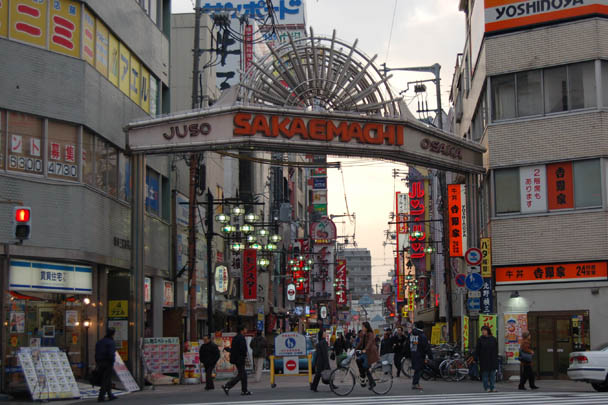
I live in Juso, a place whose name can be written shorthand as 13. When I moved from Ubuyama, I wanted to live in a place that was the polar opposite of where I spent my first two years in Japan. I really couldn't have found a place that was so foreign to the Japan I had gotten to know intimately within the same country.
It is interesting to note that a good number of people, even those who live near Juso or who regularly transfer trains in the Hankyu hub, have never been out and about in this area that?s just across the river from Umeda. They have a mostly negative view of the place. Juso is associated with lewdness, strange or handicapped people, danger, and dirtiness. Make no mistake, these things do exist here, but it's pretty tame if you've been traveling anywhere outside of Japan.
It's strange to see how the seasons affect people around here. The crazy people and perverts seem to be warded off by the cold, so the girls who live in my apartment haven't come by and asked if they can chill in my apartment for a while because some strange man was following them home (this happened quite frequently during spring and summer).
It's strange to see how skirt lengths get shorter despite the freezing winds whipping through the street.
It's amusing to see the teenage guitarists and their fan girls hanging out under the tracks of the Juso eki, and drunken salarymen occasionally drop a few thousand yen to play a request.
It's cool to see how well the homeless are getting along without any help from the outside world.
It's annoying to see 10 cops standing on a side street with whistles in mouth and pens in hand, ambushing passing cars to ticket drivers.
It's nice to hear the high school band practice next to the Yodogawa as the sun sinks into the West.
It makes you realize just how cold it is when you see the plumes of smoke coming out of the vents of the restaurants, stalls, and off of grilling takoyaki in the morning and at night. Oh, and the snow makes it abundantly clear too.
It's cool to know that if you want to buy a specific type of egg from a specific type of chicken, quail, or even duck, there is a store at the end of the shotengai where you can probably find exactly what you?re looking for.
It's an especially good sign to see that many of the izakayas and eating establishments are regularly crowded with blue collar workers, enjoying their food and drink after work to the point where you aren't always guarenteed a seat. It's also a good sign that not many young people come to these restaraunts- they go to the fancier, more expensive ones in Umeda or Minami instead. They don?t know what they?re missing.
It's nice to exchange "Ohayogozaimasu", "Ittarashai", and "Ittekimasu" with the old lady who lives in the house next to my apartment every morning on my way to work.
It's gratifying to hear people say that they like Juso, after actually coming down here and spending some time and getting to know it. It isn't a touristy area, nor is it a really happening place to be, but it has a nice balance hidden below a scruffy, slightly notorious surface. It is surprisingly quiet at nighttime.
Sure, there are some unpleasant or provocative things about Juso, but at least it is advertised clearly out in the open. It's no more a corrupt or dirty place than the surrounding areas, it's just more honest.
This morning, I woke up refreshed, dusted the crusted snow off of my drying towel for my morning shower, and then skated in the slush to work feeling that today would be a good one for taking pictures. I didn't capture any of the snow before it melted, but saw some cool stuff after I got off of work.
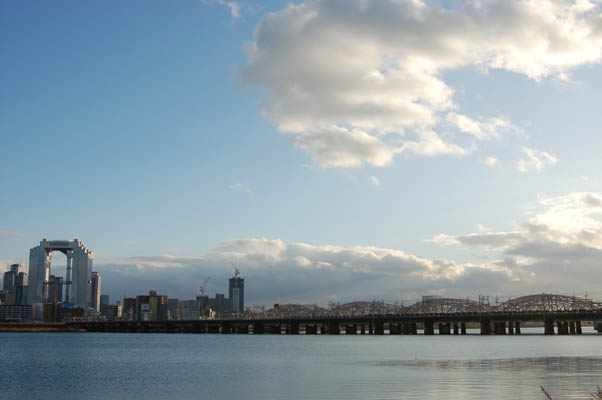
It?s amazing to see snow, rain, or whatever form precipitation decides to take, fall as the sun is shining. Today, from across the Yodogawa, I could see the snow descending on Kita, sweeping across from Hep 5 to the Sky Building. This, I though, was better viewed from a distance in the warm sunshine.
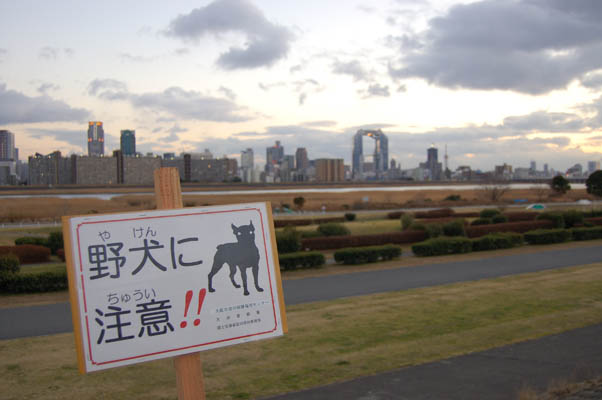
The wild dogs were out again today, roving around in packs. This is a sign warning people about them. Other signs were equally disturbing: One made a plea to people not to abandon their dogs in Yodogawa park. It said ?Dogs are nice animals. Don?t buy pets if you can?t take care of them.?. I don?t think that these signs actually change anyone?s mind about what is right and wrong. It?s hard to convert an asshole into a good person, though I wish the same could be said for the reverse.
Here?s a flyer about dogs posted over one of my favorite signs:
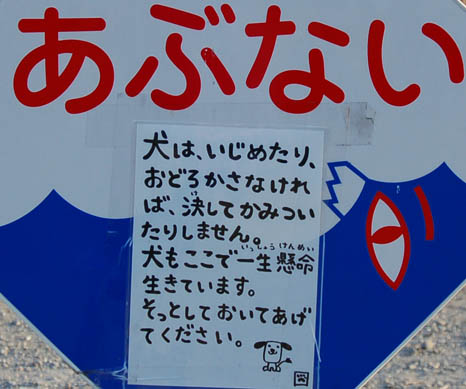
The gist of it is (correct me if I?m wrong) that you shouldn?t be mean to the dogs or surprise them, or they might bite your ass. The dogs are doing their best to live here so be gentle towards them.
It is wrong how pets are dumped in the woods (or next to the Yodogawa for that matter) if their owners get bored of them. If you drive around the country roads of Japan for any length of time, you will see lots of puppy road kill, and if you walk around in the mountains you will probably have to fight the urge to take a whimpering pup home with you. People should have to prove themselves worthy before they are allowed to have kids or pets. And if they fuck up, they shouldn?t get a second chance. Having kids and pets is a privilege, not a right.
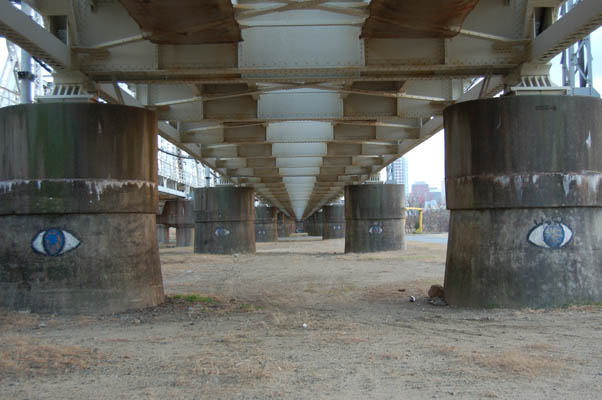
Under the JR bridge on the Shin-Osaka side of the Yodogawa, the pillars have eyes. I wish that these guys would tag more, instead of the delinquents who like to scribble on their territory much the same way that a dog raises its leg.
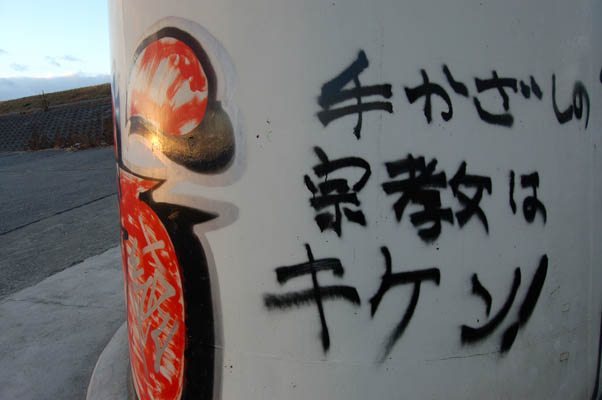
This graffiti is cool because it is dispensing some useful information: beware of religious charlatans (who hold their hand up to your head, and then claim that you?re cured, or something to that extent).
I prefer the country to the city, but living in Juso is actually pretty cool sometimes. Not only is it convenient to get to and a good place to find some cheap, authentic Kansai cuisine, but there are just so many interesting things to be seen around here.
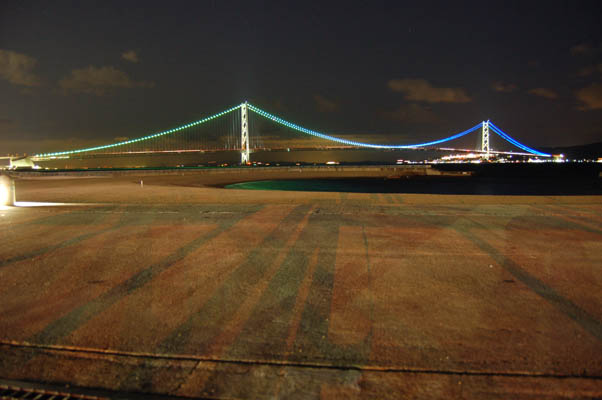
This is the Akashi Bridge that connects Awaji-shima with Kobe, as seen from the Akashi side. It doesn't look like it in the picture, but the sky was pretty dark, and you could just barely make out the beach in the dim light.
I didn't have a tripod, so I rested it on a bench. Unfortunately, a stiff, cold wind was blowing, there was a lot of light from multiple sources polluting the area, and the shutter was open for too long (about 10 seconds or so) for this picture to come out as clearly as I would have liked it to have.
Well, I guess it's time to study up on night photography and hopefully I will have some better pictures to post shortly. I don't think I'll be returning to photograph the Akashi bridge because it's too far away. Justin, you're on this.
(Porcupine fish are abundant off of the Ryukyu Islands- this is one that I saw on a dive close to Zamami island)
*Fugu is delicious, but how many people had to die before a safe technique was developed to separate the poisonous bits from the delicious, slightly toxic but safe to eat parts?
*How many sushi chefs have died after eating the liver of a fugu because they erroneously believed that they had built up an immunity to the toxin, or were egged on during a drinking session by the rest of the kitchen staff?
*Does anyone eat its cousin, the porcupine fish? It would make sense that something that is even more of a pain in the ass to catch and prepare would be even more delicious.
*It?s going to be hard to convince the Japanese in particular that it is in their best interest to cut down on the rate of seafood consumption. Even if they concede that it is necessary need to do this to protect the long-term interests of everyone regarding the declining stocks of fish, there is going to be some serious reluctance to comply with what is necessary. If they actually do cut down, I don?t want to be there to witness the withdrawal symptoms of Japan.
*Even discounting the fact that uni is sea urchin gonads, it is still disgusting. Admit it, it looks and has the consistency a baby turd.
*If you go to any Japanese aquarium and listen to the people around you, you will almost certainly hear someone say "oishisou" (that looks delicious). I wonder if they feel the same way when they visit Sea World and watch the Shamu show...
*Korean nori kicks ass! So do the technologically advanced wrappers that keep nori separate from convenience store onigiri until right before you eat them. By the way, if you?re lucky, you can sometimes find spam musubi in Japanese convenience stores.
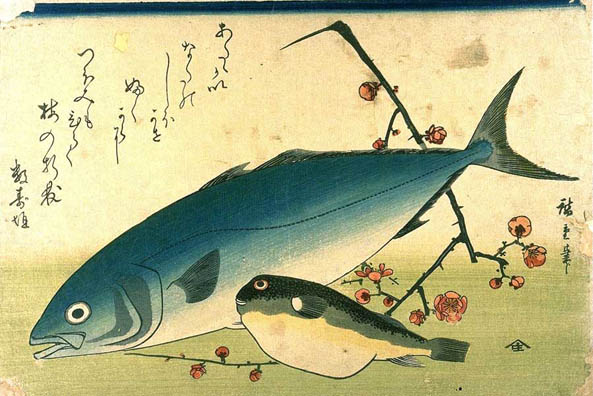
(Woodblock print by Hiroshige Ando)
*It's cool how the yellowtail has so many names in Japanese:
aoThe names vary depending on the size of the fish, the location where the fish is caught, and also are the result of different dialects. Obviously, the people who came up with these names obviously really loved this fish. I would have never known how delicious it could be if the only yellowtail I had eaten was the stuff we catch back in California, though that stuff isn't bad. In my opinion young Japanese yellowtail from cold waters make the most delicious tsukuri, Broiling the collar with a bit of salt is simply heavenly.
buri
hiramasa
inada
fukuragikando
kanburi
kozokura
mejiro
tsubasu
wakanago
wakashi
warasa
*It has been my experience that a restaurant that sells high-quality maguro and hamachi sashimi will inevitably sell out of the hamachi first. Maguro is good, but not a good enough substitute when you are really craving hamachi.
*If people looked like what they eat, then Osaka station would resemble a massive kaiten sushi restaraunt.
*Which lobster variety makes the best ise ebi sashimi? The best stuff I've had so far was from the relatively warm waters of the Amakusa Islands in Kumamoto. However, fish tend to taste better from colder waters, and lobsters lose their firmness of flesh as they get older. So would a young Maine lobster be even more delicious than one from Amakusa? How does Okinawa's ise ebi compare?
*Ordering "tsukuri" sounds cooler than ordering "sashimi", but people in Tokyo won?t know what the hell you are talking about.
*I wonder if people who regularly eat the clams from the Yodogawa are suffering any reproductive problems.
*I have been told that a really good way to catch unagi is to put an ayu in a two liter bottle and place it in a river with the mouth facing upstream. Unagi, it was explained to me, find ayu irresistible and once they squeeze into the bottle and eat the fish, they are unable to get out again. This reminds me of how some monkeys are easily trapped. Rice is put inside a hollow coconut, and when the monkey grabs onto the rice, they can?t pull their fist out of the trap. If they would only let go of the rice, their hand wouldn?t be stuck, but apparently monkeys like rice that much.
*Japanese people get confused when told that the jinbeizame (whale shark) is a fish, and some of them think that dolphins are fish. This never fails to be amusing.
*If you go swimming off of the coasts of Kyushu, don't worry about the clear jelly fish so much. It's the ones with red stripes that hurt like a bitch!
*Mutsugoro (famous in Saga-ken) is hands down the worst tasting fish I have ever eaten. If you can taste mud (a mutsugoro is a mudskipper btw) through a thick layer of teriyaki sauce, there's probably not much that you can do to improve the flavor. The second and third most repugnant marine organisms I?ve tried in Japan would have to be hotaru ika (firefly squid) and fermented whale, respectively.
*I don't like eating small fish that are candied and hard. It feels wrong in more that one way (link to small dried fish).
*Squid kicks ass in so many different ways: calamari rings with spicy salt, battered and fried in tonkatsu, tempura, and fish and chips style batter, dried, dried and coated with honey, cut up as sashimi, or even fried up as a steak or sauteed with some vegetables. It also makes a very handy all-purpose saltwater bait.
*The sushi with crunchy, yellow roe is nasty. Try some next time!
*Japanese salmonids (this includes both trout and salmon) taste a hell of a lot better than the stuff from America. For example, you can stick a skewer through a live Japanese trout, put some salt on its writhing body, broil it over some coals, and come out with some awesome fish on a stick. You can't do this with trout back home and expect it to taste good. I wonder why this is.
*Of all the seaweeds, hijiki will supposedly make your hair the most beautiful.
*Do most people who claim to like hakarl (rotten and mouldy shark flesh) really enjoy it, or is it mostly a way to prove one's virility? Considering that it is traditionally washed down with a drink nicknamed "Black Death", I am leaning toward the latter explanation.
*Has anyone calculated the number of chirimen (tiny fish generally used as a condiment for rice) eaten in Japan in an average year? I am guessing that it?s around jucchopiki (ten trillion). How about for aji?
*What do Gharabaldis taste like?
*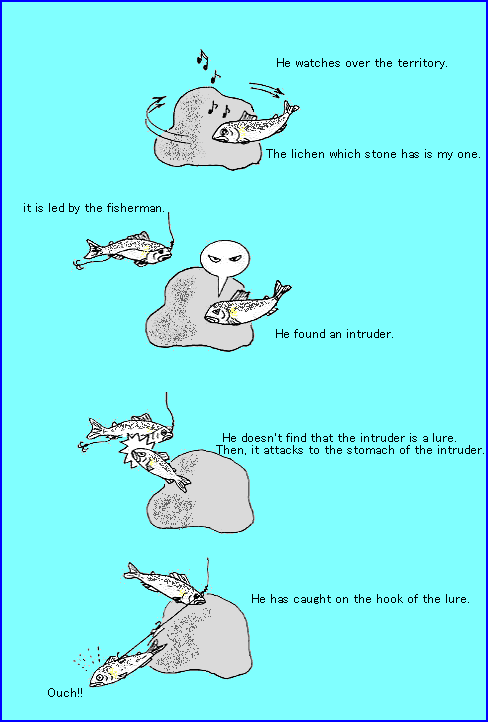
(link)
*Ayu fishing seems cruel and inhumane, though it is a very clever way to catch a fish that would otherwise be very difficult to catch on rod and reel. Ayu don?t eat bait, but they are territorial fish, so if one ayu intrudes the territory of another, it will ram it. Japanese fishermen figured out that by attaching hooks to the body of a ?rival? they could use a live fish as a lure. In order to attach the rig, you must perform some pretty serious pierce work on the fish that you will use. If you do go fishing for ayu there is a right way to set up the rig. If you cover the eyes of the fish while you are attaching the tackle to its body, it will be in much better condition and stay viable as ?bait? for a long while. If you don?t do this, it may go into shock.
*What type of fish do they use to make kamaboko and chikuwa? I want to see percentages of each species of marine organisms.
*Bioaccumulation is a motherfuckingbitch.
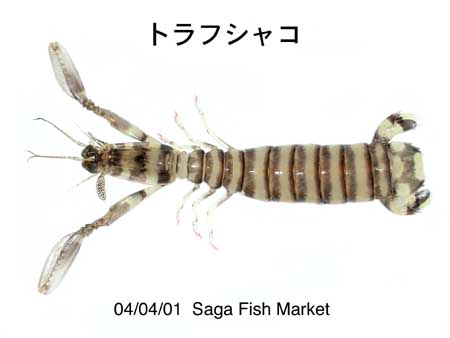
(from M. Nagano's collection)
*I have never seen anyone eat a shako (a squilla, or more commonly known as the mighty mantis shrimp) at kaiten sushi except for Matt. We had to try it at least once, because we believe that you must try everything at a kaiten sushi restaurant at least once. Before I came to Japan, I had no idea that people ate these ferocious beasts
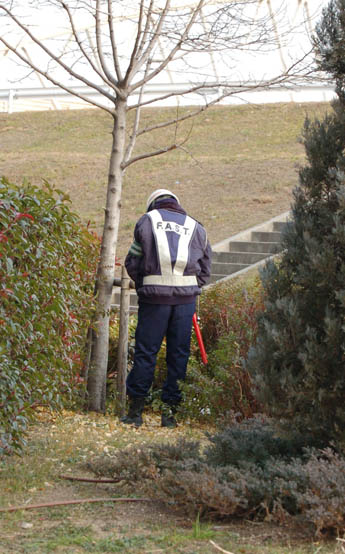
A Japanese law enforcement officer takes a whiz facing the a busy street (invisible from this angle) next to the Yodogawa river. The steady line of traffic that passed by shortly after I snapped this photo must have been able to see him, as he failed to conceal himself behind the taller shrub to his right. Maybe he was just a cosplay urination exhibitionist.
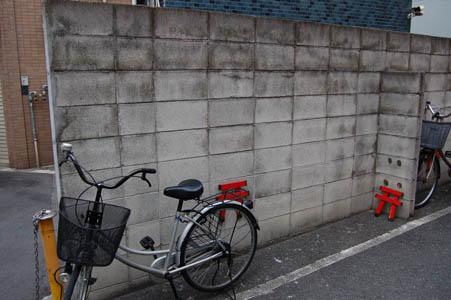
Fun fact: it is socially acceptable to whip it out and take a leak almost anywhere on the streets of Japan, especially if you are an old man.
The only way to prevent this is to put little torii (the red Shinto gate) up in places where you don't want people to piss. Pissing on a torii, as my brother explained, is like pissing on God.
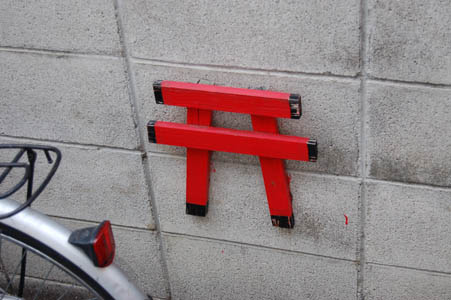
These things apparently work pretty well. Juso, famous for snack bars, colorful non-chain izakayas with an authentic Kansai atmosphere (rivaled only by Shinsekai in my humble opinion), and negiyaki (a type of okonomiyaki, which on a side note I refuse to call a Japanese pizza- who came up with that anyway!) as well as drunk people making their way home from these establishment. The fact that this particular wall does not smell like urine is a testament to the power of the mini torii to ward off those who would otherwise urinate in this area.
Update: Mark has some related pictures up at the Champon Adventures. Thanks dude!
It's been a bit warmer around Osaka lately, and like this semi I've been able to shed down a layer and enjoy the crisp air. Hopefully Spring will come early this year. It's a sad and beautiful thing, to know that this year may well be my last opportunity to enjoy Hanami in Japan. It's a shame that there aren't any cherry trees around the Yodogawa though.
Heh, it's only January and I'm already thinking about drinking under the gentle rain of cherry blossoms...
Update (Jan. 19th, 3:33 PM): Never mind, it's snowing again...
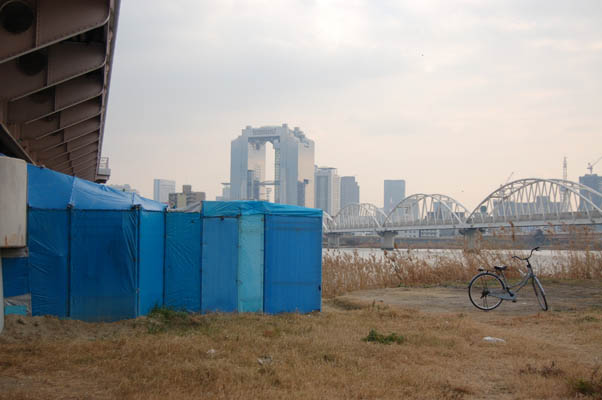
I take these pictures because I truly respect the resourcefulness that these homeless people possess. Using scavenged materials and simple blue tarps, the Yodogawa homeless population has built a community next to the river. By doing so, they have secured themselves one of the best views available in Osaka
The homeless of the Yodogawa don't bother anyone- I have never heard of anyone being molested or even bothered for spare change. Often they hang out, have a couple of drinks, and barbecue. At other times you can see them tending gardens, fishing, practicing their golf, clamming (yes, people do eat clams from the river!), or walking their dogs.
Their dogs are dangerous, though. There are wild packs that roam the banks, and it is best to be wary if you are walking around this area. It is best not to venture out around this area alone, especially at night time, and certainly if you are a female.
Anyhow, for the duration of my stay, I will be posting pictures of these amazing homes as I take them. As I don't want to upset anyone, I'll only be able to take a few at a time or risk being obvious.
Honestly, these homes are amazing- the homeless have accumulated or fabricated everything that they need (refrigerators made out of coolers, outdoor kitchens, and furniture among many other things), and maintain a relatively comfortable life. You can check here for periodic updates.
Most of the tags that people throw up around the city are ugly and uninspired, but if you look hard enough and explore the less frequented areas you can find some really good stuff. I'll be posting pictures of the better works here, so check back once in a while if you're interested.
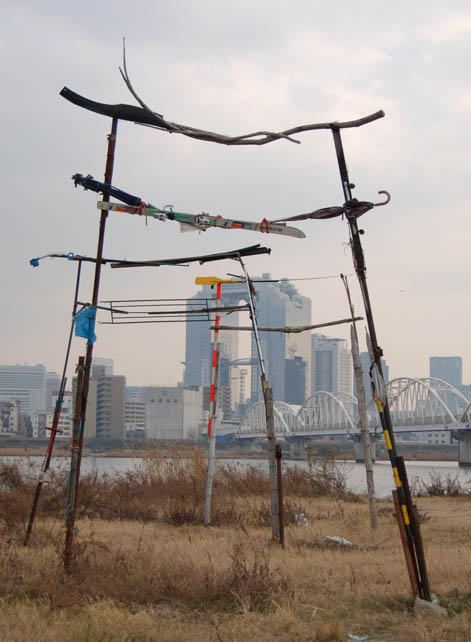
I never noticed it before, but the Sky Building is really just a huge tori.
Last year, Huw and I went on a hike through the mountains of Kobe, starting from Ashiyagawa and ending in Shukugawa. Along the way, we saw many signs with wild boars on them, but saw no real wildlife to speak of, only other hikers. This sign stands right in front of the Hankyu train station, warning the people of Ashiya about the dangers of wild boars that sometimes come down from the hills to get run over by BMWs and Mercedes Benzes. If you're going to get run over, Ashiya is definitely the place to do it!
The little kid yells "Dame!" at her dad as he gets attacked as a result of feeding the boar. Ah, this brings back so many colorful childhood memories, notably the one where my dad chased after a female black bear and her cubs in order to snap a picture. I'm just disappointed that he didn't get the picture...
Signs warning hikers against feeding or playing with the boars were more common than one might expect. Personally, if I saw a boar I wouldn't want any part of it after watching Old Yeller but I guess not that many people have seen what happens when you screw with a boar. You either get gored and end up being shot by your best friend, or you kill the boar, eat it, put its head on a stick and worship it as the God of the island. And then you kill Piggy and use his glasses to make fire.
This is a bit late/early depending on how you look at it, but I wanted to say that I'm really happy for you guys. It seems as if you two have been married for over a decade already to me, so it's fitting after waiting so long that you should get married with such a massive undertaking. Hopefully there will be many more pictures to post later.